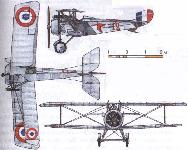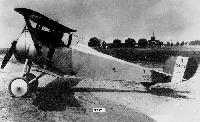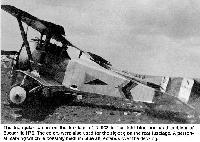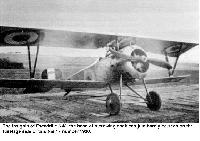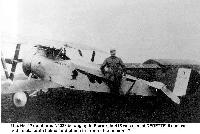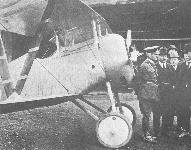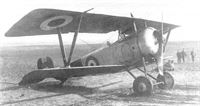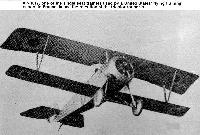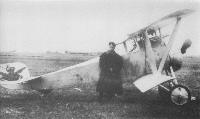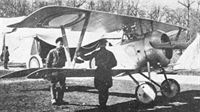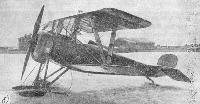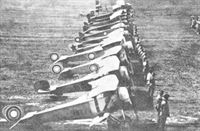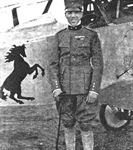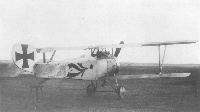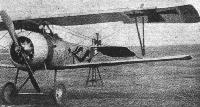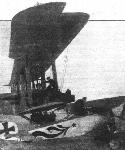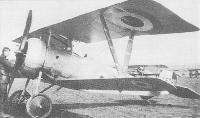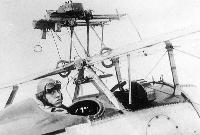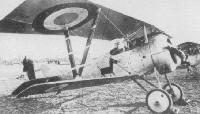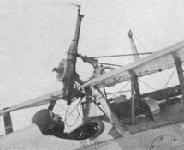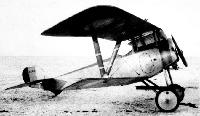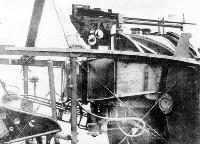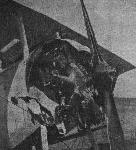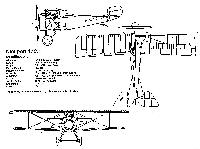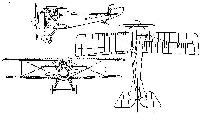
Описание
Страна: Франция
Год: 1916
Истребитель
Варианты
- Nieuport - Nieuport-11/16 Bebe - 1915 - Франция
- Nieuport - Nieuport-17/21/23 - 1916 - Франция
- Siemens-Schuckert - D.I - 1916 - Германия
- Nieuport - Nieuport-17bis/24/27 - 1917 - Франция
- В.Кондратьев Самолеты первой мировой войны
- А.Шепс Самолеты Первой мировой войны. Страны Антанты
- В.Шавров История конструкций самолетов в СССР до 1938 г.
- J.Davilla, A.Soltan French Aircraft of the First World War (Flying Machines)
- W.Green, G.Swanborough The Complete Book of Fighters
- O.Thetford Aircraft of the Royal Air Force since 1918 (Putnam)
- O.Thetford British Naval Aircraft since 1912 (Putnam)
- H.Nowarra, G.Duval Russian Civil and Military Aircraft 1884-1969
- A.Durkota, T.Darcey, V.Kulikov The Imperial Russian Air Service (Flying Machines)
- E.Hauke, W.Schroeder, B.Totschinger Die Flugzeuge der k.u.k. Luftfahrtruppe und Seeflieger 1914-1918
- J.Davilla Italian Aviation in the First World War. Vol.3: Aircraft M-W (A Centennial Perspective on Great War Airplanes 75)
-
В.Кондратьев - Самолеты первой мировой войны
Ньюпор 17, эскадрилья N-65, пилот - лейтенант Ш.Нэжессе, 1916г.
-
J.Davilla, A.Soltan - French Aircraft of the First World War /Flying Machines/
Nieuport 17 of N 124.
-
J.Davilla, A.Soltan - French Aircraft of the First World War /Flying Machines/
Nieuport 17 of N 3.
-
A.Durkota, T.Darcey, V.Kulikov - The Imperial Russian Air Service /Flying Machines/
Nieuport 17 #2232, Second Air Combat Group, spring 1917. (Yevgraph N. Kruten)
-
D.Mechin - Foreign Fronts of the French Air Force 1914-1919 /Aeronaut/
Nieuport 17 n°2592 of the N 581 squadron based in Kolotche (currently Holocha, Ukraine) and flown by Warrant Officer Paul Jalaguier, mid-June 1917. The aircraft is equipped with Le Prieur fuses.
-
J.Bruce - Nieuport Fighters /Albatros/
NIEUPORT 17, N.2778, Serg. Carre, Escadrille N.112 (?), 1917.
Finished overall in aluminium dope with natural metal cowling; French roundels in six positions with red (?) wing and fuselage bands suggesting service with Escadrille N.112. Rene and initial R shown black but may also have been red. -
D.Mechin - Oriental Adventures of the French Air force 1914-1918 /Aeronaut/
Nieuport 17 no 2780, Escadrille N 387, S/Lt Miodrag Tomic (1 victory), Vertekop, April 1917.
-
D.Mechin - Oriental Adventures of the French Air force 1914-1918 /Aeronaut/
Nieuport 17 from the escort section of escadrille 503
-
А.Шепс - Самолеты Первой мировой войны. Страны Антанты
Истребитель "Ньюпор-17" эскадрильи "Аисты" ВВС Франции (пилот Рене Дорм; 1917г.)
-
А.Шепс - Самолеты Первой мировой войны. Страны Антанты
"Ньюпор-17" 60-го истребительного дивизиона RFC (пилот У.Бишоп; 1917г.)
-
J.Bruce - Nieuport Fighters /Albatros/
Nieuport 17 B1690 of No. 1 Squadron RFC, August, 1917. Machine is doped overall aluminium with natural metal cowling which bears either black or red stripes. Fuselage numeral ‘4’ repeated on upper decking and probably applied in blue as depicted. B1690 featured a mixture of roundel proportions at one stage.
-
А.Шепс - Самолеты Первой мировой войны. Страны Антанты
"Ньюпор-17" эскадрильи "Лафайет" ВВС Франции, укомплектованной американскими добровольцами (1917г.)
-
R.Gentilli - Italian Aviation Units in the First World War. Vol.2 /Aeronaut/ (2)
Nieuport 17 Ni.2140, Sergente Guilo Poli, 70a Squadriglia, Spring 1917
-
J.Davilla - Italian Aviation in the First World War. Vol.1: Operations /Centennial Perspective/ (73)
Nieuport 17 #2614 flown by leading Italian ace Francesco Baracca on 1 January 1917 when he supposedly had a combat with Banfield. 70a Squadriglia
-
R.Gentilli - Italian Aviation Units in the First World War. Vol.1 /Aeronaut/ (1)
Nieuport 17 #2614, 91a Squadriglia, cap. Baracca, Santa Caterina, 1917
-
R.Gentilli - Italian Aviation Units in the First World War. Vol.3 /Aeronaut/ (3)
Nieuport 17 #2618, 75a Squadriglia
-
R.Gentilli - Italian Aviation Units in the First World War. Vol.2 /Aeronaut/ (2)
Nieuport 17 #3139, Ten. Fulco Ruffo di Calabri, 70a Squadriglia
-
J.Davilla - Italian Aviation in the First World War. Vol.3: Aircraft M-W /Centennial Perspective/ (75)
Nieuport 17 Ni.3602, Sgt Pagliari, 70a Squadriglia, Spring 1917
-
J.Davilla - Italian Aviation in the First World War. Vol.3: Aircraft M-W /Centennial Perspective/ (75)
Nieuport 17 N.3625, 81a Squadriglia, Campoformido Aerodrome, Autumn 1917
-
R.Gentilli - Italian Aviation Units in the First World War. Vol.2 /Aeronaut/ (2)
Nieuport 17 #3647, 71a Squadriglia, Winter 1916/17, Villaverla Aerodrome
-
J.Bruce - Nieuport Fighters /Albatros/
NIEUPORT (MACCHI-built) 17, Ni 3647, pilot and unit unknown, 1917.
Finished overall in aluminium dope with natural metal cowling. Stripe behind cockpit is depicted as red, under surfaces of wings divided into national colours. Small upper wing roundels (see detail I). -
J.Bruce - Nieuport Fighters /Albatros/
NIEUPORT (MACCHI-built) 17, Ni 3656, Serg. E Liut, 77" Squadriglia 1917.
Finished overall in aluminium dope with natural metal cowling. Under surfaces of wings divided into national colours with medium sized upper wing roundels. On this machine the fuselage roundel has been overpainted in white and a red heart added. -
J.Davilla - Italian Aviation in the First World War. Vol.3: Aircraft M-W /Centennial Perspective/ (75)
Nieuport 17 Ni.3664, Giannino Ancillotto, 80a Squadriglia
-
J.Davilla - Italian Aviation in the First World War. Vol.3: Aircraft M-W /Centennial Perspective/ (75)
Nieuport 17 Ni.3666, 71a Squadriglia
-
J.Davilla - Italian Aviation in the First World War. Vol.3: Aircraft M-W /Centennial Perspective/ (75)
Nieuport 17, Unit unknown
-
R.Gentilli - Italian Aviation Units in the First World War. Vol.3 /Aeronaut/ (3)
Nieuport 17, 76a Squadriglia, 1917
-
J.Davilla - Italian Aviation in the First World War. Vol.3: Aircraft M-W /Centennial Perspective/ (75)
Nieuport 17 markings, Port side
-
J.Davilla - Italian Aviation in the First World War. Vol.3: Aircraft M-W /Centennial Perspective/ (75)
Nieuport 17 markings, Starboard side
-
R.Gentilli - Italian Aviation Units in the First World War. Vol.3 /Aeronaut/ (3)
Nieuport 17, Serg. Giuseppe Tesei, 77a Squadriglia
-
R.Gentilli - Italian Aviation Units in the First World War. Vol.3 /Aeronaut/ (3)
Nieuport 17, 78a Squadriglia
-
A.Durkota, T.Darcey, V.Kulikov - The Imperial Russian Air Service /Flying Machines/
Dux-built Nieuport 17, 2nd Fighter Detachment, spring 1917. (Boris V. Sergievsky)
-
A.Durkota, T.Darcey, V.Kulikov - The Imperial Russian Air Service /Flying Machines/
Nieuport 17, unit unknown.
-
В.Кондратьев - Самолеты первой мировой войны
"Ньюпор-17" российского летчика Доната Макиенка из 7-го истребительного авиаотряда, лето 1917г.
-
A.Durkota, T.Darcey, V.Kulikov - The Imperial Russian Air Service /Flying Machines/
Nieuport 17, 7th Fighter Detachment, summer 1917. (Donat A. Makeenok)
-
A.Durkota, T.Darcey, V.Kulikov - The Imperial Russian Air Service /Flying Machines/
Dux-built Nieuport 17, 7th Fighter Detachment, spring 1917. (Vasili I. Yanchenko)
-
A.Durkota, T.Darcey, V.Kulikov - The Imperial Russian Air Service /Flying Machines/
Nieuport 17, 11th Corps Detachment, spring 1917. (Victor G. Federov)
-
A.Durkota, T.Darcey, V.Kulikov - The Imperial Russian Air Service /Flying Machines/
Nieuport 17, unit unknown, spring 1917.
-
A.Durkota, T.Darcey, V.Kulikov - The Imperial Russian Air Service /Flying Machines/
Nieuport 17, 19th Corps Detachment, spring 1917. (Alexander A. Kozakov)
-
А.Шепс - Самолеты Первой мировой войны. Страны Антанты
"Ньюпор-17" на лыжном шасси XIX авиаотряда русской армии (1917г.)
-
A.Durkota, T.Darcey, V.Kulikov - The Imperial Russian Air Service /Flying Machines/
Nieuport 17, 19th Corps Detachment, spring 1917.
-
J.Bruce - Nieuport Fighters /Albatros/
Nieuport 17, pilot and serial number unknown. No.19 Squadron, Imperial Russian Air Service, 1917.
Finished overall in aluminium dope with natural metal cowling. The aeroplane bears the name 'Bob’ in white and black characters, yin-yan wheel markings in the same colours and fuselage pennant in orange and black stripes representing the colours of the Order of St. George. Rudder markings are black and white. Russian roundels in six positions. -
J.Bruce - Nieuport Fighters /Albatros/
Nieuport 17, serial, pilot and unit unknown, Estonian Air Force, 1925.
Finished overall in aluminium dope with natural metal cowling, this aeroplane was particularly well-worn when photographed. Estonian triangular markings of white/deep blue/black/white applied to upper surfaces (and possibly lower surfaces) of upper wing, together with under surfaces of lower wing and fuselage sides. Rudder and elevators in equal bands of the national colours. -
A.Durkota, T.Darcey, V.Kulikov - The Imperial Russian Air Service /Flying Machines/
Nieuport 21 #1514, 19th Corps, August 1917. (Ivan V. Smirnov)
-
D.Mechin - Oriental Adventures of the French Air force 1914-1918 /Aeronaut/
Nieuport 21 no 1713 from the escort section of escadrille 502 flow by Adjudant Basile Saune in 1917.
-
A.Durkota, T.Darcey, V.Kulikov - The Imperial Russian Air Service /Flying Machines/
Nieuport 21 #1825, 12th Fighter Detachment, winter 1917. (Jaan M. Mahlapuu)
-
D.Mechin - Oriental Adventures of the French Air force 1914-1918 /Aeronaut/
Nieuport 21 no 1868, Escadrille N 387, Vrbeni, November 1916.
-
D.Mechin - Foreign Fronts of the French Air Force 1914-1919 /Aeronaut/
Nieuport 21 n°1953 of Marechal des Logis Edouard Corniglion (2 victories), escadrille N 392, Venice-Lido, 1916-1917.
-
D.Mechin - Oriental Adventures of the French Air force 1914-1918 /Aeronaut/
Nieuport 21 no 2211 of Lt de Saint Severin, escadrille N 391, Autumn 1916.
-
D.Mechin - Oriental Adventures of the French Air force 1914-1918 /Aeronaut/
Nieuport 21 no 2219, escadrille N 390, Negocani, January 1, 1917.
-
D.Mechin - Oriental Adventures of the French Air force 1914-1918 /Aeronaut/
Nieuport 21 no 2397, Escadrille N 390, January 1, 1917
-
D.Mechin - Oriental Adventures of the French Air force 1914-1918 /Aeronaut/
Nieuport 21 from escadrille N 390 showing a personal rabbit insignia.
-
D.Mechin - Oriental Adventures of the French Air force 1914-1918 /Aeronaut/
Nieuport 21 (serial unknown), escadrille C.389, Sgt Gustave Gauthier, Boresnica February 1917.
-
J.Bruce - Nieuport Fighters /Albatros/
NIEUPORT 21, N.1645, Sgt. R Lufbery, Escadrille Americaine, 1916.
Finished overall in aluminium dope with natural metal cowling. French roundels in six positions. Personal marking believed to be in red. -
А.Шепс - Самолеты Первой мировой войны. Страны Антанты
Истребитель "Ньюпор-21" французских ВВС (1917г.)
-
A.Durkota, T.Darcey, V.Kulikov - The Imperial Russian Air Service /Flying Machines/
Nieuport 21 #4572, Second Combat Air Group, spring 1917. (Yevgraph N. Kruten)
-
А.Шепс - Самолеты Первой мировой войны. Страны Антанты
"Ньюпор-21" RNAS (1917г.)
-
A.Durkota, T.Darcey, V.Kulikov - The Imperial Russian Air Service /Flying Machines/
Dux-built Nieuport 21, Naval Air Station Oesel Island, October 1917. (Alexander N. Seversky)
-
А.Шепс - Самолеты Первой мировой войны. Страны Антанты
Трофейный "Ньюпор-21", использовавшийся авиацией Австро-Венгрии (1917г.)
-
D.Mechin - Foreign Fronts of the French Air Force 1914-1919 /Aeronaut/
Nieuport 23 n°2066 of Sous-Lieutenant Pierre de Jumilhac, N 392, Venice-Lido, 1916-1917.
-
D.Mechin - Foreign Fronts of the French Air Force 1914-1919 /Aeronaut/
Nieuport 23 n°2100 of Sergent Ivan Marcou, N 392, Venice-Lido, 1917.
-
D.Mechin - Foreign Fronts of the French Air Force 1914-1919 /Aeronaut/
Nieuport 23 n°2750 of Sergent Andre Levy (6 victories), N 561, Venice-Lido, 1917.
-
D.Mechin - Foreign Fronts of the French Air Force 1914-1919 /Aeronaut/
Nieuport 23 n°2756 of Sous-Lieutenant Jean Bignon (1 victory), N 561, Venice-Lido, 1917.
-
D.Mechin - Foreign Fronts of the French Air Force 1914-1919 /Aeronaut/
Nieuport 23 n°2903 of Aspirant Marcel Robert (3 victories, including 1 in Venice), N 561, Venice-Lido, 1917.
-
D.Mechin - Foreign Fronts of the French Air Force 1914-1919 /Aeronaut/
Nieuport 23 n°3341 of Lieutenant Frederic Loiseau, N 561, Venice-Lido 1917.
-
D.Mechin - Foreign Fronts of the French Air Force 1914-1919 /Aeronaut/
Nieuport 23 n°3363 of Marechal des Logis Edouard Corniglion (2 victories), N 561, Lido 1917.
-
D.Mechin - Oriental Adventures of the French Air force 1914-1918 /Aeronaut/
Nieuport 23 no 3660, Escadrille F.388, March 8, 1917
-
D.Mechin - Foreign Fronts of the French Air Force 1914-1919 /Aeronaut/
Nieuport 23 n°3678 of Marechal des Logis Henri Boyer, N 561, Venice-Lido, 1917.
-
D.Mechin - Foreign Fronts of the French Air Force 1914-1919 /Aeronaut/
Nieuport 23 (serial unknown) of Sous-Lieutenant Jean Darbos, N 561, Venice-Lido, 1917.
-
D.Mechin - Foreign Fronts of the French Air Force 1914-1919 /Aeronaut/
Nieuport 23 (serial unknown) of Sous-Lieutenant Xavier Garros (1 victory), N 561, Venice-Lido, 1917.
-
D.Mechin - Oriental Adventures of the French Air force 1914-1918 /Aeronaut/
Nieuport 23 of the escort section from escadrille 501, Sgt Georges Baudeuf, Summer 1917.
-
D.Mechin - Oriental Adventures of the French Air force 1914-1918 /Aeronaut/
Nieuport 23 (serial unknown), Escadrille 521, Vertekop, Late 1917.
-
D.Mechin - Foreign Fronts of the French Air Force 1914-1919 /Aeronaut/
Nieuport 23 (serial unknown) of Lieutenant Daniel Chambariere, N 561, Venice-Lido 1917.
-
W.Pieters - The Belgian Air Service in the First World War /Aeronaut/
Nieuport 23 VAMPIRE, Kervyn de Lettenhove, 1ere Escadrille
-
W.Pieters - The Belgian Air Service in the First World War /Aeronaut/
Nieuport 23, Goosens-Bara, 1ere Escadrille
-
W.Pieters - The Belgian Air Service in the First World War /Aeronaut/
Nieuport 23, Verhoustraeten, 1ere Escadrille
-
W.Pieters - The Belgian Air Service in the First World War /Aeronaut/
Nieuport 23 'N3625', De Meulemeester, 1ere Escadrille
-
W.Pieters - The Belgian Air Service in the First World War /Aeronaut/
Nieuport 23 ‘N5105’, Verbessem, 1ere Escadrille
-
W.Pieters - The Belgian Air Service in the First World War /Aeronaut/
Nieuport 23 ‘N5617’, Franchomme, 5me Escadrille
-
W.Pieters - The Belgian Air Service in the First World War /Aeronaut/
Nieuport 23, Thieffry, 5me Escadrille
-
В.Кондратьев - Самолеты первой мировой войны
Ньюпор 23, 5-я эскадрилья авиации Бельгии ("Кометы"), пилот - су-лейтенант Э.Тиффри, 1917 год.
-
J.Bruce - Nieuport Fighters /Albatros/
NIEUPORT 23, serial unknown, Adjt. E Thieffry, 5eme Escadrille, 1917.
Finished overall in aluminium dope with natural metal cowling. Upper surfaces of wings, tail and fuselage overpainted in an unspecified dark colour, probably green. On the upper wing the overpainted roundels can still be discerned. Red/white Comet insignia is well worn, wheels and upper fuselage are marked with a white disc divided by a broad red stripe. -
J.Bruce - Nieuport Fighters /Albatros/
NIEUPORT 23, A’ 6786, pilot unknown, No.40 Sqn. RFC 1917.
Finished overall in aluminium dope with natural metal cowling. RFC roundels in six positions with black and white fuselage and wing markings. NB: This machine was also used by No.29 Sqn, May 1917. It had gone to No.40 Sqn on 23.3.17 and was struck off charge on 30.3.17, so it wasn't with 40 Sqn for long. It survived at least until January 12 1918, when it was recorded at No.l AD St-Omer. -
A.Durkota, T.Darcey, V.Kulikov - The Imperial Russian Air Service /Flying Machines/
Nieuport 23, 7th Fighter Detachment, spring 1917. (Tadeusz Grochowalski)
-
A.Durkota, T.Darcey, V.Kulikov - The Imperial Russian Air Service /Flying Machines/
Nieuport 23, unit unknown, December 1917. (Pilot: Kibanov)
-
А.Шепс - Самолеты Первой мировой войны. Страны Антанты
Истребитель "Ньюпор-23" боевой авиагруппы Юго-Западного фронта, на котором летал капитан Евграф Крутень
-
А.Шепс - Самолеты Первой мировой войны. Страны Антанты
"Ньюпор-23" одного из авиаотрядов РККА (1919г.)
-
A.Olejko - War Wings Over Galicia 1918-1919 /Aeronaut/
Nieuport 23 C1 belonging to the 1st Ukrainian Aviation Unit. Lt. Franz Rudorfer flew this aircraft during the period of fighting over Galicia - Spring 1919.
-
J.Bruce - Nieuport Fighters /Albatros/
Bearing the serial number of the original Nie.17 flown by Lt. W A Bishop in No.60 Sqn, RFC, this exquisite airworthy reproduction aircraft was built in 1962 by Carl Swanson at Sycamore, Illinois, and is in the collection of Canada’s National Aviation Museum at Rockcliffe, Ontario.
Inset: one observation about the Nieuport 17 that almost certainly applies to the 11 and 16 concerns the fuselage covering. Whenever the NAM Nieuport 17 had the engine running on the ground, or was flying, the fabric on the sides of the fuselage behind the cockpit ‘sucked-in’ making the vertical fuselage members stand out in relief. In bright light conditions the shadows this caused were quite noticeable while the aircraft was in flight as this photo shows. -
W.Green, G.Swanborough - The Complete Book of Fighters
The Nie 21, that being a replica with some genuine components in Brazil’s Museu Aeroespacial.
-
A.Olejko - War Wings Over Galicia 1918-1919 /Aeronaut/
Krzysztof Cwynar's Flying Circus... In southern Poland, Podkarpackie region, for several years, air shows have included two flying reproductions of fighter aircraft from the Great War, type Nieuport 11 and Nieuport 17. In 2018, their show honored the 3rd International Aviation Conference in Gorlice-Szymbark. (author's collection)
Другие самолёты на фотографии: Nieuport Nieuport-11/16 Bebe - Франция - 1915
-
A.Olejko - War Wings Over Galicia 1918-1919 /Aeronaut/
Другие самолёты на фотографии: Nieuport Nieuport-11/16 Bebe - Франция - 1915
-
Сайт - Pilots-and-planes /WWW/
By 1916 French air strength had become impressive, and with types such as the Nieuport and Spad the fighter units had capable equipment. The Nieuport 17, as N2474 here, was powered by a 110hp Le Rhone and had a top speed of 110mph (177kph).
-
Сайт - Pilots-and-planes /WWW/
Nieuport 17, possibly of Escadrille N76. This Nieuport was built in large numbers and equipped many of the French fighter squadrons, as well as a variety of Allied units.
The triangular fanion on the fuselage of N1932 is the light blue and gold emblem of Escadrille N76. The colors were also used for the zig-zag on the rear fuselage. A personal marking which is possibly medium blue aft, extends over the decking -
J.Davilla, A.Soltan - French Aircraft of the First World War /Flying Machines/
Four views of Nieuport 17 N 1424 with cone de penetration.
-
J.Bruce - Nieuport Fighters /Albatros/
This aspect of Nieuport 17 N1424 shows application of sprayed camouflage seen on early examples of the type. Patterns varied widely and although this is one of the best photographs available, high reflectivity and lighting conditions still make defining the disposition of colours extremely difficult.
-
Журнал - Flight за 1917 г.
Rear view of the Nieuport 1 1/2-plane,Type 17.
-
Журнал - Flight за 1917 г.
Front view of the Nieuport 1 1/2-plane, Type 17.
-
J.Bruce - Nieuport Fighters /Albatros/
Nieuport 17 N2779, believed to be of Esc. N.112, fell into German hands intact on April 12 1917, when Sous-Lt. Carre was obliged to make a forced landing at Leffincourt. It did not survive for long: on May 20, Ltn. Hermann Pfeiffer of Jasta 9 was killed while he was flying this aircraft.
-
J.Davilla, A.Soltan - French Aircraft of the First World War /Flying Machines/
Nieuport 17 of Escadrille N 91. The unit's insignia was an eagle carrying a bomb with a lit fuse in its talons.
-
J.Davilla, A.Soltan - French Aircraft of the First World War /Flying Machines/
A lineup of Nieuport 17s of Escadrille N 90. The unit insignia was the profile of a rooster.
-
D.Mechin - Oriental Adventures of the French Air force 1914-1918 /Aeronaut/
Nieuport 17 from the escort section of escadrille 503, 1917.
-
J.Bruce - Nieuport Fighters /Albatros/
A splendidly evocative impression of N1177 of Escadrille N.76, usually flown by Lt. Emile-Louis-Albert Paumier. His personal marking was a white eight-pointed star just visible towards the rear of the fuselage. The escadrille's emblem was a blue and gold fanion.
-
J.Davilla, A.Soltan - French Aircraft of the First World War /Flying Machines/
Nieuport 17 of Escadrille N 48 which was assigned to GC 11.
-
Сайт - Pilots-and-planes /WWW/
The insignia of Escadrille N48, the head of a crowing cock can just barely be seen on the fuselage side of this Nie.17 number 1930
-
J.Bruce - Nieuport Fighters /Albatros/
N1803 was typical of the Vickers-armed version of the Nie.17 with overall ‘silver’ finish. A narrow (one rib-space) transparent area at the root end of each upper mainplane allowed more light to fall on the centrally-placed Vickers gun.
-
M.Schmeelke - Ballon Hoch /Centennial Perspective/ (91)
MdL Marcel Caree of the N 112 attacked a German balloon near Leffincourt on April 12, 1917, where he came under fire from the ground machine guns and had to make an emergency landing with the engine stopped.
-
H.Cowin - Aviation Pioneers /Osprey/
Ground view of late production Nieuport 17, serial no N1559. With these later machines the overwing Lewis gun was replaced by a synchronised .303 inch Vickers firing through the propeller arc. N1559 is in standard French markings. The fact that the machine is fined with a totally non-standard pitot/static tube, fined to the portside 'V' interplane strut, would indicate that N1559 was involved in development flying.
-
J.Herris - Weird Wings of WWI /Centennial Perspective/ (70)
Nieuport with three guns, two of them over-wing; the pilot was ace Pierre Gaudermann of Esc 68.
-
A.Durkota, T.Darcey, V.Kulikov - The Imperial Russian Air Service /Flying Machines/
Members of escadrille N.581 at Kamnietz-Padolsk November 1917, standing before the temporary hanger and the squadron's Nieuports,. The closest Nieuport has been equipped with Le Prieur rockets.
-
J.Bruce - Nieuport Fighters /Albatros/
A line of Nie.17s of Escadrille N.26. The two nearest aircraft are armed with Vickers guns; the others appear to have overwing Lewis guns.
-
J.Bruce - Nieuport Fighters /Albatros/
The marking on the fuselage of N1741 suggests that the aircraft belonged to Escadrille N.26. The individual numeral 3 was repeated on the starboard upper wing, and a cone de penetration was fitted.
-
J.Davilla, A.Soltan - French Aircraft of the First World War /Flying Machines/
Guynemer's Nieuport 17 of SPA 3. The cone de penetration was fixed; it was not a spinner.
-
K.Delve - World War One in the Air /Crowood/
The Nieuport squadrons played a vital role in wresting air superiority from the Germans around Verdun and over the French sectors south of the Somme. This Nieuport 17 served with Escadrille N3.
-
J.Davilla, A.Soltan - French Aircraft of the First World War /Flying Machines/
Camouflaged Nieuport 17 of Capitaine Auger of SPA 3 in October 1916.
-
J.Bruce - Nieuport Fighters /Albatros/
Lt. William Thaw's Nie.17, N1582, photographed at Luxeuil, displays typical French rudder serial and weights stencil application. Armament is a centrally-mounted Vickers gun. The intersections of the interplane bracing cables provided parking places for items of flying clothing.
-
J.Herris - Weird Wings of WWI /Centennial Perspective/ (70)
Above: Close-up of Gaudermann's Nieuport with three guns.
-
J.Davilla, A.Soltan - French Aircraft of the First World War /Flying Machines/
Nieuport 17 of Jacques Allez, possibly of N 65. The man-in-the-moon insignia was probably a personal marking.
-
A.Durkota, T.Darcey, V.Kulikov - The Imperial Russian Air Service /Flying Machines/
Believed to be Revol-Tissot in the cockpit of a Nieuport 17.
-
J.Bruce - Nieuport Fighters /Albatros/
N3509’s SFA serial number was applied in such small characters (in the rudder’s white stripe) that it is all but illegible in this photograph. The wasp emblem of Escadrille N.89 is eminently visible, however, and the aircraft is a Nie.17.
-
Сайт - Pilots-and-planes /WWW/
This Nie.17 numbered N2038 belonging to Escadrille N15 was named DEDETTE III and carried an elaborate helmet and plume in front of the numeral 7
-
M.Schmeelke - Ballon Hoch /Centennial Perspective/ (91)
The Nieuport 17 of the N68, flown by Marechal de Logis Blaise Preher, was forced to land by Lt. Gebhardt Saltzwedel of the Jasta 24 on April 11, 1917. On the lower wings, the sheet metal fairings on the V-struts can be seen, which prevented the risk of fire from the Le Prieur rockets.
-
J.Bruce - Nieuport Fighters /Albatros/
Charles Nungesser with his Nie.17, N1480, during a brief temporary attachment to Escadrille Ml 24, the Escadrille Lafayette. Like N1420, Nungesser’s aircraft had a natural-metal engine cowling and a cone de penetration. On it he shot down an Aviatik over Seuzey on July 21 1916.
-
J.Davilla, A.Soltan - French Aircraft of the First World War /Flying Machines/
Nieuport 17 N1490 of Escadrille N 124. As indicated by the fuselage insignia, this airplane was flown by Charles Nungesser after his 15th victory.
-
Jane's All The World Aircraft 1919 /Jane's/
The fore-part of a Nieuport 17 "destroyer" (1916-17 type).
-
H.Cowin - Aviation Pioneers /Osprey/
A foursome of Nieuport 17s belonging to the Escadrille Lafayette, or N 124, formed of French commanded American volunteer pilots. The brainchild of Norman Price, an American lawyer, the squadron came into being on 16 April 1916, as the Escadrille Americaine, its name being quickly changed to Lafayette following German diplomatic pressure. After serving honourably under the French flag for just under two years, the unit was transferred to US control on 18 February 1918 to become the 103rd Aero Squadron, with most of its pilots being put in command of other squadrons being formed at the time, thus helping to spread this pool of hard-won combat experience. Sadly, the squadron's creator, Norman Price, along with other unit members including Raoul Lufbery, James McConnell and Kiffen Rockwell were all to die in combat. Note the squadron's Indian Head emblem.
-
H.Cowin - Aviation Pioneers /Osprey/
The Nieuport 17 went into operational service in the late spring of 1916 being a bigger, better, more powerful development of the Nieuport 11 Bebe, minus the handling problems of the Ni 16. Powered by a 110hp Le Rhone, the Ni 17 had a top level speed of 107mph at 6.560 feet giving it a level speed advantage of around 13mph over the Halberstadt D II and 16mph compared with the Fokker E III. This, combined with its superior climb and agility saw the new French fighter outclassing its German opposition to the point where the German reaction was to have Euler and Siemens-Schuckert mimic the design by 'back-engineering' a captured Nieuport 17. The early production French-operated example seen here sported a 'cone de penetration', which, unlike a normal airscrew boss, remained stationary. However, like many adornments dreamt up by the aircraft builders, these cones failed to survive long in operational useDespite the high speed manoeuvre limitations of the earlier Bebe also applying to the Ni 17, the fighter was built in quantities that approached the 1.000 aircraft mark, the type entering widespread service in France, with both the RFC and RNAS in Britain, Belgium, Italy - where 150 were licence-built by Macchi - The Netherlands and Romania.
-
A.Durkota, T.Darcey, V.Kulikov - The Imperial Russian Air Service /Flying Machines/
Gond in one of the squadron's Nieuports taking off to intercept the enemy. The Germans conducted hit and run raids on the airfield at Tecuci. On some occasions an advance call would come from headquarters, allowing the fighter pilots a few moments to become airborne before the enemy actually arrived.
-
В.Кондратьев - Самолеты первой мировой войны
Современная реплика "Ньюпора-17" в полете.
-
W.Green, G.Swanborough - The Complete Book of Fighters
An Nie 17 of the RFC, this particular example serving in Palestine with No 111 Squadron.
-
H.Cowin - Aviation Pioneers /Osprey/
The then Captain William Avery Bishop, photographed in the cockpit of his No 60 Squadron, RFC, Nieuport 17, serial no B 1556. Destined to survive World War I with a confirmed score of 72 victories, 'Billy' Bishop was born in Ontario, Canada, on 8 February 1894, Bishop was already a Lieutenant with a Canadian cavalry unit at the outbreak of war. As with other aces-to-be, Bishop started his flying career as an observer in Royal Aircraft Factory RE 7s of No 21 Squadron, RFC, during the autumn of 1915. Hospitalised with a knee injury sustained in a crash landing early in 1916, Bishop then underwent pilot training, following which he spent the rest of the year and early 1917 flying the Royal Aircraft Factory BE 2c with a UK-based anti-airship unit. In mid-March 1917, the young Canadian was posted to No 60 Squadron, RFC, operating Nieuports over the Western Front. Just over a week later, 'Billy' Bishop was to score his first 'kill'. During the next five months, Bishop's tally rose to 36, with his lone 2 June 1917 attack on a German airfield earning him the coveted Victoria Cross for exceptional bravery. After an enforced extended leave back in Canada, Major Bishop, as he now was, returned to France in mid-March to command the Royal Aircraft Factory SE 5a-equipped No 85 Squadron, RFC. Between then and 19 June 1918, 'Billy' Bishop doubled his score of confirmed victories before being effectively forced to quit operational flying for public relations reasons. Bishop returned to Canada after the war, where he helped create the Royal Canadian Air Force, becoming an Air Vice Marshal in the process. 'Billy' Bishop died on 11 September 1956.
-
J.Bruce - Nieuport Fighters /Albatros/
This captured RFC Nieuport 17 was B1514 (though some official records list it as a Nie.23). It had been at No.l AD by April 4 1917, and was with No.60 Squadron by April 22. On May 6 2/Lt. C W McKissock was obliged to land in enemy territory, and was made PoW. His aircraft had a cutaway cowling, and rocket-tube attachment points were on the interplane struts.
-
J.Bruce - Nieuport Fighters /Albatros/
B1640 went to No.40 Squadron, RFC, on May 3 1917, but its operational career was brief. On May 13, Lt. A B Raymond was obliged to land in German-held territory, shot down by Ltn. Ermecke of Jasta 33.
-
J.Bruce - Nieuport Fighters /Albatros/
A Nieuport of No.40 Squadron, RFC. In the cockpit is (it is believed) Lt. Gordon T Pettigrew, who is known to have sent down an Albatros D.V out of control on June 25 1917, while he was flying B1683.
-
J.Bruce - Nieuport Fighters /Albatros/
The first of the RFC’s many Nie.17s was, like the Nie.16s that preceded it, a transfer from the RNAS. This was SFA N1553, which came to the RFC on July 19 1916, and was numbered A200. It had a cone de penetration and transparent panels in the upper wing. A200 went briefly to No.11 Squadron, RFC, but on August 28 1916, was transferred to No.60 Squadron. Albert Ball flew it on September 15, armed with Le Prieur rockets, bent on destroying enemy balloons. Frustrated because the balloons were hauled down, he fired his rockets at a German fighter; all missed, but Ball closed and shot down the enemy. His Nieuport must have been hit, possibly by defensive ground fire, for it was sent to No.2 AD for repair on September 16. The aircraft returned to No.60 Squadron on December 16. Early in February 1917 it suffered the wing distortion that affected several Nieuports but evidently survived. Following damage late in March, it went to No.2 AD on March
-
J.Bruce - Nieuport Fighters /Albatros/
The size and proportions of the cone de penetration of the Nie. 17 can be assessed from this photograph of Lt. Albert Ball, taken in the garden of his Nottingham home while he was on leave. The RFC seemed to be quick to discard this refinement from its early Nieuports, which is probably why Ball was allowed to have his as a souvenir. It was painted red.
-
J.Bruce - Nieuport Fighters /Albatros/
The Nie.17s of ‘C’ Flight, No.29 Squadron, RFC. The aircraft at right, marked 5C, is A6788, which was at No.l AD by March 30 1917. It went to No.29 Squadron on April 9, was sent to No.2 AD for repair on May 19, but evidently returned to the unit and was finally sent to No.l AD on December 2 1917. Beside it stands A6787, which was at No.l AD by March 27 1917, and went to No.29 Squadron on April 9. On May 11, Lt. A S Shephard on this aircraft destroyed an Albatros D.III; and the Nieuport was sent to No.2 AD for repair on June 15.
-
J.Bruce - Nieuport Fighters /Albatros/
Most of the assorted Nieuports acquired by the United States Air Service were used for training purposes in France. This Nie.17 was photographed at Issoudun, wearing on its fuselage the number 31 in large characters, plus ‘15m’ in smaller characters, presumably to intimate that this was a Nieuport with 15 sq. m. wing area.
-
J.Bruce - Nieuport Fighters /Albatros/
An Escadrille Lafayette pilot, Dudley Hill, in a Nie.17 that had both a Vickers gun and an overwing Lewis. The increased fire-power was doubtless valuable, but the additional gun must have reduced the aircraft's performance seriously.
-
H.Cowin - Aviation Pioneers /Osprey/
Despite having been born in France of French parentage, Raoul Gervais Victor Lufbery has deservedly gone into the annals of aviation as one of the brave young men who helped in the forging of US military aviation during World War I. Lufbery was born on 14 March 1885, emigrating with his parents to the US at the stare of the 1890s. At seventeen and footloose, Lufbery ran away from home, travelling to Europe and the Middle East before returning to the US to join the Army as a rifleman. It was the US Army that furthered his knowledge of the world by sending him to the Philippines, from where, on Army discharge, he proceeded to explore South East Asia in 1910. Two years on and Lufbery's path crosses that of French pilot, Marc Pourpe, who hired Lufbery as the mechanic for his Bleriot. At the outbreak of war both men were still together and, by now, back in France, Pourpe volunteered and with his previous flying experience soon found himself with Escadrille N 23. Initially rejected as a foreigner by the French authorities, Lufbery was contemplating joining the French Foreign Legion when Pourpe, in need of a tried and trusted mechanic, intervened on his behalf. Sadly, shortly after rejoining Pourpe, his benefactor was killed. During the late spring of 1915, Lufbery was selected for pilot training, gaining his 'wings' on 29 July 1915. His introduction to combat came in October 1915 piloting two seater Voisins with Escadrille VB 106. Happily for Lufbery, he was selected for single seaters early in 1916 and following type conversion training joined the Nieuport 11-equipped Escadrille Lafayette on 24 May 1916. French-led, this unit was manned by American volunteer pilots. Here, within the space of less than five months, Lufbery made his mark by becoming an ace, that is having amassed the necessary five 'kills', on 12 October 1916. Commissioned in early 1917, Lufbery continued flying for the French with the Escadrille Lafayette until January 1918, when the unit and its personnel were transferred to the American Expeditionary Forces's control. By now holding the US rank of major, Lufbery was given command of the 94th Aero, equipped with Nieuport 28s. This unit became operational on 19 March 1918 and two months later Raoul Lufbery was killed after falling from his blazing Nieuport on 19 May 1918. Seen here standing besides his Nieuport 17, with its Escadrille Lafayette's Indian Head emblem. Lufbery's ultimate confirmed score stood at 17 'kills'.
-
Сайт - Pilots-and-planes /WWW/
A Nie.17, one of the single seat trainers used by a United States' flying training school in France, hence the retention of the tricolor roundels
-
H.Cowin - Aviation Pioneers /Osprey/
Both manpower and material were major initial contributions America brought to the war as pictured by these US Army Signal Corps mechanics re-assembling Nieuport 17s at Issoudun in France during May 1917. After August 1917, Issoudun was to become the biggest and best known of the sixteen American advanced flying training schools established in France. At the time of the Armistice, these flying training schools were producing around 2.000 pilots per month, including those undergoing refresher training.
-
J.Bruce - Nieuport Fighters /Albatros/
A close-up of a Duks-built Nie. 17 said to have been taken at the firm's Moscow factory.
-
A.Durkota, T.Darcey, V.Kulikov - The Imperial Russian Air Service /Flying Machines/
Nieuport 17, pilot and unit unknown. The aircraft's rudder was decorated with a white witch's head on black background.
-
A.Durkota, T.Darcey, V.Kulikov - The Imperial Russian Air Service /Flying Machines/
Nieuport 17 of the 19th Corps Detachment. Cyrillic letters denote 'BOB.' The pennant of orange and black denotes the orange and black colors for the Order of Saint George. The white skull on black rudder was a unit marking.
-
H.Nowarra, G.Duval - Russian Civil and Military Aircraft 1884-1969
Nieuport 17 of No. 1 Fighter Group, displaying the white skull and crossbones originally identifying the XIX (Death or Glory) Corps Air Squadron. The fuselage inscription reads ‘Bob’. The significance of the name ‘Bob' is not known.
-
A.Durkota, T.Darcey, V.Kulikov - The Imperial Russian Air Service /Flying Machines/
A Nieuport 17 of the 19th Corps Fighter Detachment, nicknamed the "Death or Glory" detachment because of the unusual unit markings (white or black skull) applied to the rudder of each aircraft.
-
A.Durkota, T.Darcey, V.Kulikov - The Imperial Russian Air Service /Flying Machines/
A Nieuport 17 from the 19th Corps Fighter Detachment.
-
A.Durkota, T.Darcey, V.Kulikov - The Imperial Russian Air Service /Flying Machines/
Praporschik Longin Lipsky with his Nieuport 17. Lipsky teamed with Smirnov to obtain several victories.
-
A.Durkota, T.Darcey, V.Kulikov - The Imperial Russian Air Service /Flying Machines/
Makeenok, standing second from left, scored several of his victories in this Nieuport 17. This machine's unusual markings included a rudder adorned with a white owl on black shield. The side of the fuselage has a painting depicting a young girl in white dress, carrying a sword and cross. An unfurling flag is located diagonally from her right arm and flowing down across her feet. The flag's colors are unknown but presumed to be Polish in nature. Reportedly, this image was applied to both sides of the aircraft.
-
A.Durkota, T.Darcey, V.Kulikov - The Imperial Russian Air Service /Flying Machines/
Nieuport 17s from the 7th Fighter Detachment, spring 1917. Yanchenko's aircraft (to right of photo) was a Dux-built Nieuport 17. An extra Madsen machine gun is mounted on the top wing and there is a black shield insignia on white background.
-
A.Durkota, T.Darcey, V.Kulikov - The Imperial Russian Air Service /Flying Machines/
Nieuport 21 of the 7th Fighter Detachment flown by Grochowalski. The rudder had a black shield which displayed the Order of Saint George, Fourth Class. Grochowalski survived the war with one victory and later became a key figure in the establishment of the Polish Air Force during 1919-20.
-
A.Durkota, T.Darcey, V.Kulikov - The Imperial Russian Air Service /Flying Machines/
French-built Nieuport 17 (serial 3224). Overall finish of this French-supplied machine was silver.
-
K.Delve - World War One in the Air /Crowood/
The Eastern Front remained very much a ground war although air operations did grow in importance during 1916; the Russians continued to rely on foreign aircraft, such as this Nieuport 17.
-
A.Durkota, T.Darcey, V.Kulikov - The Imperial Russian Air Service /Flying Machines/
Russian Ensign Alexander Riaboff standing beside his Nieuport 17. His personal marking was the detailed image of Il'ya Muromets flying on an eagle's back which appeared on the rudder.
-
L.Andersson - Soviet Aircraft and Aviation 1917-1941 /Putnam/
The first aircraft used by the RKKVF were French types taken over from the Imperial Russian Air Fleet in 1917. This Nieuport fighter has an interesting and unusual type of national insignia.
-
H.Nowarra, G.Duval - Russian Civil and Military Aircraft 1884-1969
Nieuport 17 at Kiev retains Imperial roundels.
-
A.Durkota, T.Darcey, V.Kulikov - The Imperial Russian Air Service /Flying Machines/
Pishvanov seated in the cockpit of his Nieuport 17 fighter, circa summer 1917.
-
A.Durkota, T.Darcey, V.Kulikov - The Imperial Russian Air Service /Flying Machines/
Dux-built Nieuport 17 with roundels in 14 positions. The unit and date are unknown; however, the red star that appears on the rudder roundel indicates the civil war period. The unusual serpent markings run the length of the fuselage.
-
A.Durkota, T.Darcey, V.Kulikov - The Imperial Russian Air Service /Flying Machines/
Nieuport 17 fighter being positioned on the airfield for a mid-day patrol. The Nieuport was a very light aircraft and easily moved by several men as illustrated by this photograph. Loiko obtained four of his confirmed victories in this type.
-
D.Mechin - Foreign Fronts of the French Air Force 1914-1919 /Aeronaut/
Nieuport 17s of the N 581 squadron guarded by a sentry at Kolotche (today Holhocha, Ukraine) where the unit settled on June 20, 1917, just before the Kerenski offensive (Coll. Albin Denis)
-
A.Durkota, T.Darcey, V.Kulikov - The Imperial Russian Air Service /Flying Machines/
Members of the 1st Corps Detachment conduct Sunday Mass. The detachment's aircraft (Nieuport 17s and 21s) have been positioned around a make-shift alter.
-
A.Durkota, T.Darcey, V.Kulikov - The Imperial Russian Air Service /Flying Machines/
The lineup of Nieuports of the 11th Corps Detachment on the Galician Front. Federov served with this unit during 1917. The Star of David, the squadron insignia, is visible on the rudder of the two planes to the right.
-
A.Durkota, T.Darcey, V.Kulikov - The Imperial Russian Air Service /Flying Machines/
Aircraft of the First Combat Air Group lined up in Galicia, April 1917 The first four machines (Nieuport 17, Spad 7, Nieuport 10, and Dux-built Nieuport 17) were used by Kozakov and have rudders decorated with dark skulls on white backgrounds, opposite of other aircraft in the 19th Corps Detachment.
The field of Jezerzany is also occupied by the 1st Combat Group of the Russian Air Force (1st BAG), gathering three fighter squadrons, and led by Captain Alexander Kazakov. While the staff aircraft (the four planes in the foreground) bear a black skull and crossbones on a white background, those of the 19th KAO bear the same skull and crossbones with white reversed colors on a black background. In the background, 6 Nieuports of the 4th KAO can be seen wearing a white six-pointed star on a red background, then, barely visible, the aircraft of the 2nd KAO wearing a yellow ace of spades on a black background, or vice versa.Другие самолёты на фотографии: Nieuport Nieuport-10 - Франция - 1915SPAD S.VII (Spa 7C-1) - Франция - 1916
-
A.Durkota, T.Darcey, V.Kulikov - The Imperial Russian Air Service /Flying Machines/
Aircraft of the 19th Fighter Detachment lined up at Guilche airfield, Galicia, April 1917. The mix of Nieuports (types 10, 16, and 17) are both French-and Russian-built. The Morane Saulnier I was used by Smirnov to score two victories. Standard detachment markings were black skull on white rudder or white skull on black rudder.
Другие самолёты на фотографии: Morane-Saulnier N/I/V (Morane-Monocoque) - Франция - 1914Nieuport Nieuport-10 - Франция - 1915Nieuport Nieuport-11/16 Bebe - Франция - 1915
-
H.Nowarra, G.Duval - Russian Civil and Military Aircraft 1884-1969
1st Red Air Force fighter unit, 1918;
-
H.Nowarra, G.Duval - Russian Civil and Military Aircraft 1884-1969
Airfield scene at Petrograd in 1917. The aircraft shown are a Sopwith 1 1/2 Strutter, Caudron G.4, Nieuport 24bis and Nieuport 17.
Другие самолёты на фотографии: Caudron G.4 - Франция - 1915Nieuport Nieuport-17bis/24/27 - Франция - 1917Sopwith 1 1/2-Strutter - Великобритания - 1915
-
H.Nowarra, G.Duval - Russian Civil and Military Aircraft 1884-1969
Spads, Nieuports, 1 1/2 Strutters and Farmans of the Red Air Force.
Другие самолёты на фотографии: Farman F.30 - Франция - 1915Sopwith 1 1/2-Strutter - Великобритания - 1915SPAD S.VII (Spa 7C-1) - Франция - 1916
-
H.Nowarra, G.Duval - Russian Civil and Military Aircraft 1884-1969
Kazan Air Detachment, 1919.
Другие самолёты на фотографии: Sopwith 1 1/2-Strutter - Великобритания - 1915
-
H.Nowarra, G.Duval - Russian Civil and Military Aircraft 1884-1969
Nieuports and Farmans under construction at the Dux factory in Moscow. Founded in 1910, this concern also built Voisin and Morane aircraft. By mid-1917 Dux was producing two machines a day.
Другие самолёты на фотографии: Farman F.30 - Франция - 1915
-
A.Durkota, T.Darcey, V.Kulikov - The Imperial Russian Air Service /Flying Machines/
Dux Nieuports which appear finished and ready for delivery. This building, obviously not the factory, is most likely a storage facility to house the completed airplanes until shipment.
-
J.Bruce - Nieuport Fighters /Albatros/
Believed to be in Belgian service, this Vickers-armed Nie.17, evidently in use in July 1917, had a quartered square marking, probably in red and white.
-
J.Bruce - Nieuport Fighters /Albatros/
With a name perhaps chosen to proclaim the bloodthirstiness of its pilot, this Belgian Nie.17 had, by way of emphasis, both Vickers and Lewis guns.
-
W.Pieters - The Belgian Air Service in the First World War /Aeronaut/
A Breguet from 2me Esc failed to return from a recce-mission on 22 October 1918. Adjt Rene Gerard and Capt Victor Biver were shot down by ground fire and taken prisoner.
-
J.Davilla - Italian Aviation in the First World War. Vol.3: Aircraft M-W /Centennial Perspective/ (75)
A French-built Nieuport 17 in Italian service
-
R.Gentilli - Italian Aviation Units in the First World War. Vol.3 /Aeronaut/ (3)
The ace serg. Giovanni Nicelli.
-
R.Gentilli - Italian Aviation Units in the First World War. Vol.2 /Aeronaut/ (2)
Cap. Giorgio Chiaperotti in a brand-new French Nieuport 17 at Villaverla.The photo is signed with a dedication to his Group commander. (Archive De Antoni).
-
R.Gentilli - Italian Aviation Units in the First World War. Vol.3 /Aeronaut/ (3)
Baracca scored his first victories in May 1917 flying Nieuport 17 2614, showing his insignia of the black prancing horse. (Archive Lino Schifano)
-
R.Gentilli - Italian Aviation Units in the First World War. Vol.5 /Aeronaut/ (5)
A bullet hole through the rudder of Baracca's Nieuport 17 2614.
-
R.Gentilli - Italian Aviation Units in the First World War. Vol.2 /Aeronaut/ (2)
Italian-built Nieuport 17 3647 of the 71a Squadriglia at Villaverla.
A Macchi-built Nie.17, presumably Vickers-armed. The presentation of the serial number, Ni.3647, is typical of Italian practice, and it is noteworthy that the roundels on the upper wing do not extend over the ailerons. -
R.Gentilli - Italian Aviation Units in the First World War. Vol.3 /Aeronaut/ (3)
Nieuport 17 3625 fell in Austrian hands, together with Pomilio PD 3818. (Archive Jiry Cejka)
Другие самолёты на фотографии: Pomilio PC / PD / PE - Италия - 1916
-
R.Gentilli - Italian Aviation Units in the First World War. Vol.3 /Aeronaut/ (3)
French-built Nieuport 17 2613 of the 77a Squadriglia.
-
R.Gentilli - Italian Aviation Units in the First World War. Vol.3 /Aeronaut/ (3)
Mario De Bernardi in the cockpit of a brand new French-built Nieuport 17 carrying the Vickers machine gun. (Archive Fiorenzo Longhi)
-
R.Gentilli - Italian Aviation Units in the First World War. Vol.3 /Aeronaut/ (3)
Alongside the 450 locally-built Nieuport 11s, Nieuport-Macchi also produced a follow-on batch of 150 Nieuport 17s. Seen here with its proud, young pilot is serial no Ni 3632. Note the command pennant that partially obscures the first letter of the aircraft's serial no.
-
R.Gentilli - Italian Aviation Units in the First World War. Vol.3 /Aeronaut/ (3)
Sergente Cesare Magistrini; after the war he was an airline pilot, reaching 20,000 flight hours.
-
J.Davilla - Italian Aviation in the First World War. Vol.3: Aircraft M-W /Centennial Perspective/ (75)
Giannino Ancillotto of 80a Squadriglia in the cockpit of his Nieuport 17 #3664.
-
Z.Czirok - Austro-Hungarian Fighter Units of WWI. Volume 1 /Aeronaut/ (1)
Ten. Giovanni Ancilotto was participant in the air battle over the airfield at San Fior on 28th October 1918. (Roberto Gentilli)
-
J.Davilla - Italian Aviation in the First World War. Vol.3: Aircraft M-W /Centennial Perspective/ (75)
Sgt. Pagliari of 70a Squadriglia and his Nieuport 17 #3602 in spring 1917.
-
J.Bruce - Nieuport Fighters /Albatros/
A portrait study of Sergente Ferrucio Zampieri of the 77a Squadriglia in Ni.3656, a Nie.17 bearing the unit’s emblem of a red heart on white disc, superimposed on the position of the fuselage roundel.
-
R.Gentilli - Italian Aviation Units in the First World War. Vol.3 /Aeronaut/ (3)
Nieuport 17 3592 with an elaborate version of the star, insignia of the 80a Squadriglia. (Archive Luigino Caliaro)
-
J.Bruce - Nieuport Fighters /Albatros/
A Nie.17 of uncertain nationality, possibly in an Italian unit, or a French escadrille in Italy. The skull-and-crossbones emblem might even suggest a connexion with the 19th Squadron of the Imperial Russian Air Service. What is clear here is the centrally placed securing point for the absent Vickers gun.
-
R.Gentilli - Italian Aviation Units in the First World War. Vol.3 /Aeronaut/ (3)
All the pilots of 76a Squadriglia in front of French-built Ni.17 3130. From the left, Fanti, Olivero, Appiani, Retino, Venchiarutti, De Carolis, Olivi, Bonavoglia, Arrigoni.
-
R.Gentilli - Italian Aviation Units in the First World War. Vol.3 /Aeronaut/ (3)
Ten. Ruffo di Calabria in his Nieuport 17 with a macabre insignia.
-
R.Gentilli - Italian Aviation Units in the First World War. Vol.3 /Aeronaut/ (3)
Nieuport 17 3568 in Albania; in the center of the roundel there is a personal insignia, too small to be deciphered. This fighter returned to Italy and was assigned to the flying school at Busto Arsizio.
-
R.Gentilli - Italian Aviation Units in the First World War. Vol.3 /Aeronaut/ (3)
S.ten. Aldo Anesini with Nieuport 17 3132 with both a Vickers and a Lewis gun, and a roundel over the deck of the fuselage.
-
R.Gentilli - Italian Aviation Units in the First World War. Vol.3 /Aeronaut/ (3)
Nieuport 17 3587 of the 81a Squadriglia. (Archive Luigino Caliaro)
-
R.Gentilli - Italian Aviation Units in the First World War. Vol.3 /Aeronaut/ (3)
Sergente Giovanni Riva in a Nieuport 17 showing the simple markings of the 78a Squadriglia, a pennant.
-
R.Gentilli - Italian Aviation Units in the First World War. Vol.3 /Aeronaut/ (3)
The Nieuport 17 of Tesei. The caption says: "It raised the wrath of the Supreme Command for the innocent good luck charm painted on the rudder."
-
R.Gentilli - Italian Aviation Units in the First World War. Vol.3 /Aeronaut/ (3)
The prancing horse appeared on both sides of Nieuport 2614, here showing oil stains after a flight.
-
R.Gentilli - Italian Aviation Units in the First World War. Vol.3 /Aeronaut/ (3)
Serg. Cerutti, wearing a woman's stocking as a hat, and serg. Imolesi in front of a Nieuport 17, that is armed with just a Lewis; the Vickers gun is missing.
-
R.Gentilli - Italian Aviation Units in the First World War. Vol.3 /Aeronaut/ (3)
Prince Ruffo progressed with a series of ever more realistic and scary skulls.
-
R.Gentilli - Italian Aviation Units in the First World War. Vol.3 /Aeronaut/ (3)
Sergente Imolesi in a Nieuport 17 adorned with a horse shoe. This fighter is fitted with a Vickers and a Lewis gun.
-
R.Gentilli - Italian Aviation Units in the First World War. Vol.3 /Aeronaut/ (3)
General Di Robilant, commander of the 4a Armata, visiting the 2s Sezione, 83a Squadriglia, at San Pietro in Campo.
-
R.Gentilli - Italian Aviation Units in the First World War. Vol.2 /Aeronaut/ (2)
French-built Nieuport 17 3123 and a Spad of 71a Squadriglia at Villaverla. The pilot is the gallant serg. Francesco Tola, who earned two Silver Medals.
Другие самолёты на фотографии: SPAD S.VII (Spa 7C-1) - Франция - 1916
-
R.Gentilli - Italian Aviation Units in the First World War. Vol.3 /Aeronaut/ (3)
The Nieuport 17 of ace Baracchini showing his insignia, a black shield. (Archive Luigino Caliaro)
-
R.Gentilli - Italian Aviation Units in the First World War. Vol.3 /Aeronaut/ (3)
Captured Nieuport 17 3606, that got the Austrian serial 00.60. (Archive Zoltan Czirok)
-
R.Gentilli - Italian Aviation Units in the First World War. Vol.3 /Aeronaut/ (3)
A French Nieuport 17 with both a Vickers and a Lewis gun.
-
R.Gentilli - Italian Aviation Units in the First World War. Vol.3 /Aeronaut/ (3)
French-built Nieuport 17 2618 of the 75a Squadriglia.
-
R.Gentilli - Italian Aviation Units in the First World War. Vol.3 /Aeronaut/ (3)
Pilots with a French-built Nieuport 17. The Vickers machine gun is not fitted, there is a Lewis gun on the top wing.
-
J.Davilla - Italian Aviation in the First World War. Vol.3: Aircraft M-W /Centennial Perspective/ (75)
Pilot with his Nieuport 17. The synchronized machine gun was an improvement compared to the over-wing mounting of the Nieuport 11.
-
J.Davilla - Italian Aviation in the First World War. Vol.1: Operations /Centennial Perspective/ (73)
This photo of Baracca dates from approximately May 1917, relatively soon after he joined the 91st squadron, known as the La Squadriglia Degli Assi (the aces squadron), and shows Baracca's first use of his now famous prancing horse insignia, the symbol which is now used by Ferrari cars after Enrico Ferrari was given permission for its use by Barraca's mother after the war.
-
R.Gentilli - Italian Aviation Units in the First World War. Vol.2 /Aeronaut/ (2)
Three French-built Nieuport 17s, the first one of serg. Poli, the second one, with skull and crossbones, of ten. Ruffo, and the third one, with the prancing horse, of cap. Baracca.
-
J.Davilla - Italian Aviation in the First World War. Vol.3: Aircraft M-W /Centennial Perspective/ (75)
Squadriglia lineup of Nieuport 17s in Italian service. The second one, with skull and crossbones, is the plane of ace Fulco Ruffo di Calabria, the third one with prancing horse of ace Francesco Baracca.
-
R.Gentilli - Italian Aviation Units in the First World War. Vol.2 /Aeronaut/ (2)
A line-up of the 70a Squadriglia; four Nieuport 11 and three Nieuport 17.
Другие самолёты на фотографии: Nieuport Nieuport-11/16 Bebe - Франция - 1915
-
R.Gentilli - Italian Aviation Units in the First World War. Vol.3 /Aeronaut/ (3)
The fighters of the 76a Squadriglia. The second Ni.11 carries Le Prieur rockets, the ninth airplane is a French-built Nieuport 17.
Другие самолёты на фотографии: Nieuport Nieuport-11/16 Bebe - Франция - 1915
-
J.Davilla - Italian Aviation in the First World War. Vol.3: Aircraft M-W /Centennial Perspective/ (75)
Lineup of Nieuport 17s of 77a Squadriglia at Aiello.
-
R.Gentilli - Italian Aviation Units in the First World War. Vol.3 /Aeronaut/ (3)
Three different types, Spad, Nieuport 11, and Nieuport 17, of the 77a Squadriglia at Aiello.
Другие самолёты на фотографии: Nieuport Nieuport-11/16 Bebe - Франция - 1915SPAD S.VII (Spa 7C-1) - Франция - 1916
-
R.Gentilli - Italian Aviation Units in the First World War. Vol.3 /Aeronaut/ (3)
The fighters of the 77a Squadriglia at Aiello.
Другие самолёты на фотографии: Nieuport Nieuport-11/16 Bebe - Франция - 1915SPAD S.VII (Spa 7C-1) - Франция - 1916
-
R.Gentilli - Italian Aviation Units in the First World War. Vol.3 /Aeronaut/ (3)
The long line-up of the Nieuport 17s of the 85a Squadriglia at Tahiraqua, Albania.
-
R.Gentilli - Italian Aviation Units in the First World War. Vol.3 /Aeronaut/ (3)
A Nieuport 11, an Hanriot, and a Nieuport 17 of the 82a Squadriglia at Padua. In the background there are three Capronis and two SVAs of the 87a Squadriglia.
Другие самолёты на фотографии: Ansaldo SVA.2/3/4/5 - Италия - 1917Caproni Ca.1 - Ca.3 (Ca.30 - Ca.36) - Италия - 1914Hanriot HD.1 - Франция - 1916Nieuport Nieuport-11/16 Bebe - Франция - 1915
-
R.Gentilli - Italian Aviation Units in the First World War. Vol.3 /Aeronaut/ (3)
The long line-up of the Nieuport 17s of the 85a Squadriglia at Tahiraqua, Albania.
-
R.Gentilli - Italian Aviation Units in the First World War. Vol.3 /Aeronaut/ (3)
Two Hanriots and two Ni.17s of the 78a Squadriglia at Borgnano.
Другие самолёты на фотографии: Hanriot HD.1 - Франция - 1916
-
R.Gentilli - Italian Aviation Units in the First World War. Vol.3 /Aeronaut/ (3)
Fighters of the of the flight of the 79a Squadriglia at Nove di Bassano in early 1918, with a Ni.27 with unusual supports for a gun over the top wing, two Ni.17 and a Hanriot, in the background a SVA of the 2a Sezione.
Другие самолёты на фотографии: Ansaldo SVA.2/3/4/5 - Италия - 1917Hanriot HD.1 - Франция - 1916Nieuport Nieuport-17bis/24/27 - Франция - 1917
-
R.Gentilli - Italian Aviation Units in the First World War. Vol.3 /Aeronaut/ (3)
Nieuport 17s of the 3a Sezione. The third airplane, 3619, seems to have a darker color on the top wing.
-
R.Gentilli - Italian Aviation Units in the First World War. Vol.3 /Aeronaut/ (3)
The brand-new Nieuport 17s of the 2a Sezione, 83a Squadriglia.
-
R.Gentilli - Italian Aviation Units in the First World War. Vol.3 /Aeronaut/ (3)
Squadriglia lineup of Nieuport 17s in Italian service; #3632 at left, followed by 3620 at right.
-
R.Gentilli - Italian Aviation Units in the First World War. Vol.3 /Aeronaut/ (3)
A mixed line of Spads and Nieuports of different models in Macedonia.
Другие самолёты на фотографии: SPAD S.VII (Spa 7C-1) - Франция - 1916
-
R.Gentilli - Italian Aviation Units in the First World War. Vol.3 /Aeronaut/ (3)
A ceremony for the award of medals at Aiello airfield, probably on 2 October 1917, with an apparently new Nieuport 17 of 80a Squadriglia. The Duke of Aosta, commander of the 3a Armata, is in the center, with crossed arms, to his right Gen. Maggiorotti and to his left Col. Moizo, of the air force command. It is remarkable that after two and a half years of war so few medal ribbons are to be seen.
-
R.Gentilli - Italian Aviation Units in the First World War. Vol.4 /Aeronaut/ (4)
Ca.3 4175 of the 201a Squadriglia at Marcon carries the Lion of St. Mark on its nose, behind it a Nieuport 17 of the 80a Squadriglia.
Другие самолёты на фотографии: Caproni Ca.1 - Ca.3 (Ca.30 - Ca.36) - Италия - 1914
-
R.Gentilli - Italian Aviation Units in the First World War. Vol.2 /Aeronaut/ (2)
Caudron G.4 2062 of the 43a Squadriglia; behind it is a Nieuport 17 of the defense flight attached to this unit. (Archive Achille Vigna)
Другие самолёты на фотографии: Caudron G.4 - Франция - 1915
-
J.Davilla, A.Soltan - French Aircraft of the First World War /Flying Machines/
Nieuport 17 N 1831 flown by Lt. Santa Maria which was captured by the Germans. The aircraft was brought down by FI. Abt. 65. J.M. Bruce/G.S. Leslie via Colin Owers.
-
K.Delve - World War One in the Air /Crowood/
Nieuport 17 in German hands.
-
Журнал - Flight за 1917 г.
Nieuport single-seater fighter, Type 17, with fixed machine gun.
-
Журнал - Flight за 1917 г.
Nieuport single-seater fighter, Type 17, with fixed machine gun.
-
Журнал - Flight за 1918 г.
THE LONG AND THE SHORT OF IT. - A Handley-Page bomber and a Nieuport single-seater are objects for Hun curiosity.
Другие самолёты на фотографии: Handley Page O/100 / H.P.11 - Великобритания - 1915
-
J.Bruce - Nieuport Fighters /Albatros/
A Nie.17, formerly of Escadrille NAS (the cockerel’s head part of the escadrille’s well-known marking can be seen to left of the German cross on the fuselage) but here pressed into instructional service with the Jastaschule at Valenciennes.
-
J.Bruce - Nieuport Fighters /Albatros/
A Nie.17 of the Estonian air force, photographed at Tallinn in 1925.
-
J.Bruce - Nieuport Fighters /Albatros/
Among the motley collection of Nieuports operated by the Finnish air service in its earliest years was this Duks-built Nie.17. Initially numbered D86/18, it was given the new identity of ID453, and was in service during the period 1918 - 1923. In Winter it was flown with a ski undercarriage. It could have been one of two Nie.l7s (N1899 and N1900) that were flown to Finland in April 1918 by two White Russian officers, Captains Igor and Oleg Zaizewsky.
-
Jane's All The World Aircraft 1919 /Jane's/
Three-quarter rear view of the type XXIII Nieuport.
-
J.Bruce - Nieuport Fighters /Albatros/
In the Nie.23 the Vickers gun was slightly to starboard of centre, its interrupter gear being actuated by a cam on the engine’s distributor ring. The disposition of fuselage cross members was revised to serve as a mounting for the gun. The Nie.23 in this photograph was an aircraft of Escadrille N. 506, the Escadrille d’Athene.
-
D.Mechin - Foreign Fronts of the French Air Force 1914-1919 /Aeronaut/
Close-up view of Nieuport 23 n°3363 of MdL Edouard Comiglion. Very fluent in Italian language, he decorated his aircraft with the Italian imprecation "Ocio! Fiol d'un can" which translates as "Beware, son of a dog" (Paolo Varriale)
-
J.Davilla, A.Soltan - French Aircraft of the First World War /Flying Machines/
Nieuport 24bis (23 ???) serial number 3363 of N 561 escorting an Italian seaplane. N 561 was assigned to the protection of Venice and remained in Italy until the end of the war.
-
D.Mechin - Foreign Fronts of the French Air Force 1914-1919 /Aeronaut/
Close-up view of Nieuport 23 n°3363 of MdL Edouard Comiglion. Very fluent in Italian language, he decorated his aircraft with the Italian imprecation "Ocio! Fiol d'un can" which translates as "Beware, son of a dog" (Paolo Varriale)
-
D.Mechin - Foreign Fronts of the French Air Force 1914-1919 /Aeronaut/
View of the hangars of the Lido airfield, base of escadrille N 561, at the end of the summer of 1917. One can see three Nieuport 23s on alert: lieutenant Frederic Loiseau's n°3361 "Elefante Nero", marechal des logis Edouard Corniglion's n°3363 "Ocio - Fiol d'un can", and sergent Ivan Marcou's n°2100 "Rondinella". At this date, all the aircraft of the squadron carry a personal decoration. (Paolo Varriale)
-
D.Mechin - Foreign Fronts of the French Air Force 1914-1919 /Aeronaut/
Views of Lieutenant Frederic Loiseau's Nieuport 23 #3361 flying over the city of Venice. His Nieuport was christened "Elefante nero", or "Angry Elephant". (SHD)
-
D.Mechin - Foreign Fronts of the French Air Force 1914-1919 /Aeronaut/
Nieuport 23 of Loiseau in flight.
-
D.Mechin - Oriental Adventures of the French Air force 1914-1918 /Aeronaut/
Nieuport 23 from escadrille 506 near Florina during year 1917, with Capitaine de Thezy, the commanding officer, on the foreground.
-
D.Mechin - Oriental Adventures of the French Air force 1914-1918 /Aeronaut/
Escadrille N 391 at Topcin in March 1917, after having received Nieuport 23s with 110 hp engines. We note that the aircraft do not bear any particular marking.
Другие самолёты на фотографии: Nieuport Nieuport-10 - Франция - 1915
-
D.Mechin - Oriental Adventures of the French Air force 1914-1918 /Aeronaut/
Alignment of Nieuport 23 of escadrille 523 in June 1917, now stationed at Vertekop. Two SPAD VII's can be seen on the right. The Nieuports all bear personal symbols, although on several of them a flower seems to be visible (Collection Albin Denis)
Другие самолёты на фотографии: SPAD S.VII (Spa 7C-1) - Франция - 1916
-
D.Mechin - Oriental Adventures of the French Air force 1914-1918 /Aeronaut/
Line-up of three Nieuport 23s of escadrille 523 at Vertekop during the summer of 1917. All have a tactical number, but no squadron or personal insignia. (Collection Albin Denis)
-
D.Mechin - Oriental Adventures of the French Air force 1914-1918 /Aeronaut/
Corporal Emile Delauzun, mechanic of escadrille 523, poses in front of a Nieuport 23 of the unit at Vertekop on August 13, 1917 (Collection Albin Denis)
-
D.Mechin - Oriental Adventures of the French Air force 1914-1918 /Aeronaut/
Dieudonne Costes, ace of the aces of the Front d'Orient (left), in front of the Nieuports of his squadron at the end of 1917. (Collection Benoit Henriet)
-
D.Mechin - Oriental Adventures of the French Air force 1914-1918 /Aeronaut/
Sergent Charles Fugier at the commands of his Nieuport 23 belonging to the escort section of escadrille 521, in late 1917. In front of the propeller is his mechanic, soldier Faux. (Collection Albin Denis)
-
D.Mechin - Oriental Adventures of the French Air force 1914-1918 /Aeronaut/
Nieuport 23 of sergent Maxime Hantz, decorated with the panther insignia. (Collection Albin Denis)
-
D.Mechin - Oriental Adventures of the French Air force 1914-1918 /Aeronaut/
Nieuport 23 of sergent Maxime Hantz, decorated with the panther insignia. (Collection Albin Denis)
-
D.Mechin - Oriental Adventures of the French Air force 1914-1918 /Aeronaut/
Nieuport 23 no 2780 of S/Lt Miodrag Tomic decorated with the Serbian flag, seen on April 30, 1917. (Collection Boris Ciglic)
-
D.Mechin - Oriental Adventures of the French Air force 1914-1918 /Aeronaut/
Nieuport 23 no 3704 from escort section of escadrille 525 in Boresnica, 1917. (Collection Laurent Winer)
-
D.Mechin - Oriental Adventures of the French Air force 1914-1918 /Aeronaut/
Take-off on alert of the aircraft of the 507 squadron, early 1918. In the foreground, a Nieuport 23, while a Nieuport 24 can be seen in the background. (Collection Benoit Henriet)
Другие самолёты на фотографии: Nieuport Nieuport-17bis/24/27 - Франция - 1917
-
D.Mechin - Oriental Adventures of the French Air force 1914-1918 /Aeronaut/
An acrobat at his leisure, Marechal des Logis Georges Viallet, of squadron no 506 (formerly 390), was photographed in his Nieuport 23 by the Farman he was escorting, during the late summer of 1917. This pilot won a confirmed aerial victory on February 6, 1917 in the Orient Army... (Coll. Jean Vaissade)
-
D.Mechin - Foreign Fronts of the French Air Force 1914-1919 /Aeronaut/
A professional officer from the cavalry, as illustrated by the pilot's personal badge, aspirant Marcel Robert began his career with eight days' detention in a fortress... For refusing to be assigned to N 561, preferring to fight on the French front. He arrived in Italy on June 7, 1917, and left on his first leave in France in April 1918, ending the war at escadrille SPA 124. He won three air victories during the war, including one in Italy. He then had a long career in the French airforce (SHD).
-
D.Mechin - Foreign Fronts of the French Air Force 1914-1919 /Aeronaut/
Lieutenant Daniel Chambariere in his Nieuport 23 decorated with a very popular Italian cartoon character, the "cittadino che protesta" (the citizen who protests) that appeared on a humoristic magazine with the stories written by Oronzo Marginati, nom de plume of the writer Luigi Locatelli. "Ferma!!" means "Stop!!" in Italian. Chambariere ended the war as commanding officier of escadrille SPA 162 where he won 4 victories, having under his orders marechal des logis Corniglion, as him veteran from escadrille N 561.
-
D.Mechin - Foreign Fronts of the French Air Force 1914-1919 /Aeronaut/
Integrating N 561 on July 7,1917 in a contingent of four pilots, Sergeant Andre Levy decorated his personal Nieuport with a bulldog, a decoration that was repeated on his following aircraft. (SHD)
-
J.Davilla, A.Soltan - French Aircraft of the First World War /Flying Machines/
Nieuport 23 of N 92. The Nieuport 23 had a new interrupter gear which required the Vickers gun to be fitted a few centimeters to starboard of the centerline.
-
H.Cowin - Aviation Pioneers /Osprey/
Externally almost identical to the later Nieuport 17s, the Nieuport 23 was fitted with a 120hp Le Rhone and carried its Vickers gun on the port, or left-hand side of the upper nose, rather than the top centre as on late model 17s. Top level speed of the Ni 23 was 115mph at sea level. The machine shown here, N1895, was the personal mount of French ace, Charles Nungesser.
-
H.Cowin - Aviation Pioneers /Osprey/
Charles Eugene Jules Marie Nungesser ended his war with 45 confirmed victories, placing him in third place among France's leading air aces. Seen here leaning against his Nieuport 23, serial no N1895, resplendent with his macabre personal emblem. Nungesser was born in Paris on 15 March 1892. Clearly both impetuous and self-confident, the young Nungesser had run off to Argentina at the age of 16, where he made his first flight, 'soloing' the machine immediately afterwards. Commissioned as a cavalry officer into the 2nd Hussars prior to the war, Nungesser found himself overtaken by the advancing German in August 1914, coolly extricating himself by ambushing an enemy staff car, shooting its two occupants, and using it to make his escape. For this feat, along with an earlier act of bravery, Nungesser received the Medaille Militaire, along with a transfer to the flying service. On 8 April 1915 and by now a qualified pilot, he joined Escadrille VB 106, flying two-seat Voisins. It was while flying one of these sedate pushers in the autumn of 1915 that he was to make his first 'kill' by downing an Albatros two seater. Clearly, this victory marked him as being fighter pilot material, his transfer to Escadrille N 65, with its single seat Nieuport 11s following in November 1915. Once with N 65, Nungesser displayed an impressive aggression, as reflected in his ever-mounting tally of 'kills'. Reckless to the point of foolhardiness, helped, no doubt, by the military publicists, Charles Nungesser was feted wherever he went despite the fact that he spent much time in hospital recovering not only from enemy-inflicted wounds, but car crashes of his own making. Nungesser was to survive the war, his legend following him to the end, when, on 8 May 1927, accompanied by Francois Coli in the Levasseur 'Oiseau Blanc', he took off in an attempt to make the first east-west Atlantic crossing by aeroplane. Neither the aircraft or its crew were ever seen again.
-
D.Mechin - Oriental Adventures of the French Air force 1914-1918 /Aeronaut/
Nieuport 23 nicknamed "Medoc" (a French wine region, near Bordeaux) and decorated with the badge of escadrille 508.
-
D.Mechin - Oriental Adventures of the French Air force 1914-1918 /Aeronaut/
Assigned to the no 501 squadron at the western end of the front, in the Albanian mountains, the pilot, Georges Baudeuf, does not seem to be satisfied with his assignment and expresses this on his Nieuport 23. (Rene Germain, coll. Albin Denis)
-
D.Mechin - Oriental Adventures of the French Air force 1914-1918 /Aeronaut/
Pilot Georges Baudeuf (left) and his mechanic Paul Pedoux on July 15, 1917. Baudeuf changed the unit insignia by putting the word "Zut" ("Heck!") instead of the winged star.
-
D.Mechin - Oriental Adventures of the French Air force 1914-1918 /Aeronaut/
Pilots and observers of escadrille 501 in 1917, in front of a Nieuport 23. A Farman stands on the foreground. (Albin Denis collection)
Другие самолёты на фотографии: Farman F.40 - Франция - 1915
-
D.Mechin - Foreign Fronts of the French Air Force 1914-1919 /Aeronaut/
A French Nieuport in Jezerzany on June 21, 1917.
-
J.Bruce - Nieuport Fighters /Albatros/
A Nie.23 of No.40 Squadron RFC; believed to be A6786. The RFC found that in the Nie.23 there was a different disposition of packing pieces at the inboard ends of the upper wing panels, consequently different drillings had to be made for the securing bolts of the Foster gun-mounting.
-
W.Green, G.Swanborough - The Complete Book of Fighters
The Nie 23 served side-by-side in French escadrilles with the fundamentally similar Nie 17.
-
J.Bruce - Nieuport Fighters /Albatros/
B3494 had been with No.29 Squadron, RFC, in France in July 1917; on July 31 2/Lt. D F Hilton, flying this Nieuport 23, destroyed two balloons, one at Westhoek that morning, the other at Polygon Racecourse that evening. On August 9 he drove down an Albatros D.V out of control near Langevarde, another east of Houthulst Forest two days later, and a third east of Zonnebeke on August 16. By January 21 1918, B3494 was in Egypt and was in the Repair Park; as at February 12 it had engine No. 100939/ WD9025. This photograph was reported to have been taken in Palestine: if correct, that could imply possible use by No.14 or No.111 Squadron.
-
J.Bruce - Nieuport Fighters /Albatros/
This Nie.23, thought to be of No.l Squadron, RFC had what looked like a variant of one of the French types of Lewis-gun mounting, not a Foster mounting, despite the instructions of June 13 and November 20 1916, that RFC Nieuport scouts were to be fitted with the Foster.
-
A.Durkota, T.Darcey, V.Kulikov - The Imperial Russian Air Service /Flying Machines/
Nieuport 23 with Russian pilot Kibanov. Each side of the fuselage displayed a different image of a horse's head. The top deck was decorated with crossed riding crops and a horse shoe for good luck. Kibanov was shot down near Minsk on October 11, 1917.
Although in Russian service, this Nie.23 had apparently retained its French roundels and rudder stripes, but had supplementary flying wires. The pilot's flying suit was generally similar to the British Sidcot. -
J.Bruce - Nieuport Fighters /Albatros/
N3389 was another Russian Nie.23 with its French markings unchanged. In this case the aircraft had been captured intact by the Germans.
-
A.Durkota, T.Darcey, V.Kulikov - The Imperial Russian Air Service /Flying Machines/
Sergievsky, with his Dux-built Nieuport 23, while serving as temporary Detachment Commander from June 19, 1917 to September 2, 1917, when Stabs-Kapitan (Staff Captain) Baftalovsky was recovering from his wounds. He flew Nieuport 21s and 23s almost exclusively and developed some of his own aerial tactics during this time.
-
Сайт - Pilots-and-planes /WWW/
Operated by Czarist Russia while wearing French colors, this machine was captured by the Germans. Its identity may have been N3389
-
A.Durkota, T.Darcey, V.Kulikov - The Imperial Russian Air Service /Flying Machines/
Lineup of Nieuport aircraft at the front, circa 1917. From right to left - Nieuport 23 (dark rudder with white number 9), French built Nieuport 21.
-
L.Andersson - Soviet Aircraft and Aviation 1917-1941 /Putnam/
The most significant event on the Eastern Front was the Bolshevik revolution in Russia that led to the Russian exit from the war. This Nieuport 17 was in Russian service and, as shown by the markings, went on to serve the Bolshevik forces.
Many Nieuport 10, 17, 21, 23, 24, 25 and other models were taken over by the RKKVF. This is probably a Nieuport 23. -
В.Шавров - История конструкций самолетов в СССР до 1938 г.
"Ньюпор-XXIII"
-
C.Owers - Fokker Aircraft of WWI. Vol.7: Postwar /Centennial Perspective/ (67)
Fokker E.V CWL 00.4 (190/18) belonging to porucznik Julian Jasinski, a pilot of the 19th Fighter Squadron (16.EM). In early of June the Fokker monoplane was moved from Borysov to the Priyamino airfield for repair and repainting. Priyamino was the home base of the Red Aviation 4th Aero Group commanded by the famous pilot Aleksey D. Shirinkin. At this location was a storage facility for damaged and captured aircraft. On June 3, 1920, porucznik pilot Julian Jasinski got lost during a delivery flight to the front of the renovated monoplane when he was not carrying ammunition. Aircraft was was shot from the ground and on a damaged. Pilot emergency landed near Borisov on June 3, 1920. and was captured. After he was captured, Soviet propaganda publicized the incident stating that the Polish pilot had fled to their side. After the war, the pilot recalled that before he was sent to a PoW camp, according to the traditions of the Western Front from World War I, he was hosted for two days in the Shirinkin squadron. The aviator also provided exhaustive testimony, as a result of which he was completely cleared of any adverse allegations. During WWII he served in the PSP in Great Britain in 1942-43 as a ground defence officer in 308 and 315 Polish Fighter Squadron and then he was the chief of staff until 1946 in 303 Polish Fighter Squadron. A Soviet Nieuport 23 from 4th ASG can be seen in the background. Note also the stump mounted anti-aircraft Lewis machine gun.
Другие самолёты на фотографии: Fokker E.V/D.VIII - Германия - 1918
-
J.Bruce - Nieuport Fighters /Albatros/
Sous-Lieutenant P Braun of the Aviation militaire beige in his Nie.23, armed with twin Lewis guns. The parallel forward attachments for the missing Vickers gun clearly show the extent to which that gun was offset on the Nie.23.
S/Lt Pierre Braun scored his first official victory on 20 August 1917. -
W.Pieters - The Belgian Air Service in the First World War /Aeronaut/
Baron Edmond Desclee in front of his Nieuport 23 of the 5me Escadrille. The unit marking was a comet; the comet’s tail of Desclee’s aircraft had an inscription reading VA OU JE TE POUSSE (beat it or I’ll make you).
-
W.Pieters - The Belgian Air Service in the First World War /Aeronaut/
Teddy Franchomme’s Nieuport N23 was still flown in 1918. Sous-Lieutenant Louis Robin flew it after he gained his wings.
S/Lt Louis Robin, 7me Esc, was the most active pilot in May 1918, flying no less than 53 war missions, during which time he attacked several hostile aircraft in his outdated, second hand, Nieuport N23.
Nieuport 23 N5017 of the Escadrille Comete, the main subject of the cover painting, reveals markings anomalies with an apparently dark tailplane and wing roundels under transformation, the port appears in French colours while the starboard marking has been overpainted. The red paint used to apply the fuselage insignia was obviously of poor quality! -
W.Pieters - The Belgian Air Service in the First World War /Aeronaut/
Adjudant Teddy Franchomme, 5me Escadrille de Chasse, returns from an offensive patrol.
-
W.Pieters - The Belgian Air Service in the First World War /Aeronaut/
S/Lt Jacques Goethals was in combat with German ace Lt Xaver Dannhuber on 27 September 1917. Both were each others equal.
-
W.Pieters - The Belgian Air Service in the First World War /Aeronaut/
S/Lt Jacques Goethals, 10me Esc, who was at the front since 1915, was still an active and aggressive fighter pilot in 1918.
-
W.Pieters - The Belgian Air Service in the First World War /Aeronaut/
Jules Goossens-Bara in his Nieuport 23.
-
W.Pieters - The Belgian Air Service in the First World War /Aeronaut/
Adjudant Jules Goossens in his N23 above Flanders’ fields. The pilot, however, seems to be so tall that it is possible that it is Ier Sergent-Major Gusto de Mevius, who also flew this aircraft on a regular basis.
-
W.Pieters - The Belgian Air Service in the First World War /Aeronaut/
I Sgt Georges Kervyn, Iere Esc, had a minor revenge to the loss of his brother on 21 August 1917, claiming his second confirmed victory.
-
W.Pieters - The Belgian Air Service in the First World War /Aeronaut/
Capt Paul Hiernaux, Iere Esc, was attacked by an Allied aircraft on 3 July 1917.
-
W.Pieters - The Belgian Air Service in the First World War /Aeronaut/
Robert De Leener in his Nieuport 23, 5me Escadrille.
-
W.Pieters - The Belgian Air Service in the First World War /Aeronaut/
De Meulemeester and Coppens with a Nieuport 23.
-
W.Pieters - The Belgian Air Service in the First World War /Aeronaut/
ISgtMr Andre De Meulemeester and novice pilot, Sgt Georges Kervyn de Lettenhove, Iere Esc, scored a combined victory on 12 June 1917.
-
W.Pieters - The Belgian Air Service in the First World War /Aeronaut/
Adjt Andre De Meulemeester, Iere Esc, scored two victories in July 1917 to bring his total to four.
-
W.Pieters - The Belgian Air Service in the First World War /Aeronaut/
Adjt Andre De Meulemeester, Iere Esc, scored his 6th victory on 4 November 1917.
-
W.Pieters - The Belgian Air Service in the First World War /Aeronaut/
I Sgt Alfred Mouton is flanked by I Sgt Gusto de Mevius & Adjt Jules Goossens, Iere Esc.
-
W.Pieters - The Belgian Air Service in the First World War /Aeronaut/
Sous-Lieutenant Sacha Petrowski received this brand new N23, #N5020, and decorated it with yellow & red bars on its wheel covers. In the background can be seen N23 Vampire and N16 Moustique.
Другие самолёты на фотографии: Nieuport Nieuport-11/16 Bebe - Франция - 1915
-
J.Bruce - Nieuport Fighters /Albatros/
The presence of the emblem of the Escadrille Comete leaves little doubt of the identity of this Nie. 23 flown by Thieffry. Its upper surfaces are overpainted in a dark colour and the machine bears the familiar red/white markings on the upper fuselage repeated on the wheel covers.
-
W.Pieters - The Belgian Air Service in the First World War /Aeronaut/
Adjt Edmond Thieffry scored the first double for the Av.M. on 3 July 1917, bringing his score to 6.
-
W.Pieters - The Belgian Air Service in the First World War /Aeronaut/
S/Lt Edmond Thieffry in front of his Nieuport 23 while serving with Sme Escadrille. While flying a SPAD VII and serving with 10me Escadrille, he was shot down and made POW on 23 February 1918. At that time he had 10 victories and was Belgium’s leading ace.
-
W.Pieters - The Belgian Air Service in the First World War /Aeronaut/
Sgt Carlo Verbessem, Iere Esc, crashed this new Nieuport N23 on 19 August 1917.
-
W.Pieters - The Belgian Air Service in the First World War /Aeronaut/
Ier Sergent Armand Verhoustraeten flew this Nieuport N23 with green line on the fuselage.
-
W.Pieters - The Belgian Air Service in the First World War /Aeronaut/
Air mechanic Schagt in front of a Nieuport N23.
-
W.Pieters - The Belgian Air Service in the First World War /Aeronaut/
The N23 seen from above over the front.
-
W.Pieters - The Belgian Air Service in the First World War /Aeronaut/
This is how machine guns were tested. Sometimes, the target was missed, and on one occasion, such a machine gun test ended with the death of a cow. From then on these tests were forbidden.
-
W.Pieters - The Belgian Air Service in the First World War /Aeronaut/
SPAD VIIs Sp7 & Sp5 flanked by an unknown SPAD. In the background can be seen at least three Nieuport N23s.
Другие самолёты на фотографии: SPAD S.VII (Spa 7C-1) - Франция - 1916
-
K.Delve - World War One in the Air /Crowood/
Nieuport 23 N2903 of N561, a unit that formed part of the air defence of Venice.
-
E.Hauke, W.Schroeder, B.Totschinger - Die Flugzeuge der k.u.k. Luftfahrtruppe und Seeflieger 1914-1918
Nieuport 23 C.1, Ni 3349, rumänisches Beuteflugzeug; nach der Notlandung am 30. September 1916 in Szentkatolno, Flik 31. Spätere Flugzeugnummer 00.51
Nieuport 23 C.1, Ni 3349, румынский трофейный самолет; после аварийной посадки 30 сентября 1916 г. в Сенткатольно, Flik 31. Позже получил номер 00.51 -
J.Herris - DFW Aircraft of WWI /Centennial Perspective/ (29)
To the left of this Finnish Nieuport 23 is the nose of a DFW C.V in Finnish national markings after the war.
Другие самолёты на фотографии: DFW C.V - Германия - 1916
-
J.Bruce - Nieuport Fighters /Albatros/
A Nie.23 of the Czechoslovakian air service in the early inter-war years.
-
J.Bruce - Nieuport Fighters /Albatros/
Details of the cockpit area and Vickers installation can be seen in this photograph of Stephen Bigelow of the Escadrille Lafayette, notably the inconveniently-placed firing lever for the gun. A rear-view mirror is mounted in the cutout in the wing trailing edge.
-
D.Mechin - Oriental Adventures of the French Air force 1914-1918 /Aeronaut/
Nieuport 21 no 1965 of the Vertekop detachment, depending from escadrille 523 then stationed at Vrbeni, in March 1917. This detachment was composed of Serbian pilots, such as Captain Branko Vukosavljevic, leaning here against the propeller of his aircraft which bears no particular marking. (Collection Boris Ciglic)
-
Jane's All The World Aircraft 1919 /Jane's/
A Nieuport "biplan de chasse" or "destroyer" (1916-17 type). The mounting of the gun on the top plane is of interest.
-
D.Mechin - Oriental Adventures of the French Air force 1914-1918 /Aeronaut/
Pilot of escadrille N 391, Lt de Saint-Severin is photographed in front of his Nieuport 21, probably visiting the N 390 squadron in Boresnica in the autumn of 1916.
-
D.Mechin - Oriental Adventures of the French Air force 1914-1918 /Aeronaut/
Serbian pilot Sinisa Sefanovic in a Nieuport 21 from escort section of escadrille 524. (Collection Boris Ciglic)
-
D.Mechin - Oriental Adventures of the French Air force 1914-1918 /Aeronaut/
Sergent Gustave Gauthier in front of his Nieuport 21 from the escort section of C.389, Boresnica February 1917.
-
D.Mechin - Oriental Adventures of the French Air force 1914-1918 /Aeronaut/
Nieuport 21 no 2369 in Boresnica during mid-1917. (Collection Laurent Winer)
-
J.Bruce - Nieuport Fighters /Albatros/
Probably an early Nie.21, possibly of an operational escadrille. A Lewis gun is present, and the numerals might have been unit identification numbers.
-
D.Mechin - Oriental Adventures of the French Air force 1914-1918 /Aeronaut/
Nieuport 21 with the red cowling of escadrille N 390, showing a personal marking during year 1917. (Collection Boris Ciglic)
-
J.Davilla, A.Soltan - French Aircraft of the First World War /Flying Machines/
Nieuport 21, serial N1647, of Andre Chainat of SPA 3. The Nieuport 21 had the fuselage of a Nieuport 11 and the wings of a Nieuport 17. The engine was an 80 hp Le Rhone 9C.
-
D.Mechin - Oriental Adventures of the French Air force 1914-1918 /Aeronaut/
Another view of the aircraft of Serbian pilot Sinisa Sefanovic, wearing a personal insignia - actually the squadron insignia of escadrille 13 in France. (Collection Boris Ciglic)
-
J.Davilla, A.Soltan - French Aircraft of the First World War /Flying Machines/
Breguet BM 4 named Queen Mary. The airplane adjacent to the BM 4 is a Nieuport 21.
Другие самолёты на фотографии: Breguet 4/5/6/12 - Франция - 1915
-
D.Mechin - Oriental Adventures of the French Air force 1914-1918 /Aeronaut/
French and Serbian pilots of the N 387 squadron photographed at Vrbeni in November 1916. In the center, under the propeller, second lieutenant Marcel Thirouin, one of the best pilots of the orient aviation, holder of 3 confirmed aerial victories, including one won in Serbia in 1915. (Coll Boris Ciglic).
-
D.Mechin - Oriental Adventures of the French Air force 1914-1918 /Aeronaut/
French pilots in Boresnica in 1917, around a Nieuport 21. (Collection Boris Ciglic)
-
D.Mechin - Oriental Adventures of the French Air force 1914-1918 /Aeronaut/
The Nieuport 21, a hybrid version of the Nieuport 11 with its 80 hp engine and the Nieuport 17 with its wing, became the standard fighter of the French Armee d'Orient in the fall of 1916. The three aircraft in the picture, two of which are wearing personal decorations, were stationed at Vrbeni in November 1916 (Collection Boris Ciglic)
-
D.Mechin - Oriental Adventures of the French Air force 1914-1918 /Aeronaut/
Farman F.40 wearing F 382 markings in Vertekop. Nieuport 21 escort fighters can be seen in the background. (Collection Boris Ciglic)
Другие самолёты на фотографии: Farman F.40 - Франция - 1915
-
D.Mechin - Oriental Adventures of the French Air force 1914-1918 /Aeronaut/
The Nieuport 21 was the standard fighter of the French Orient Army during the year 1916. Very maneuverable, it was underpowered with its 90 hp engine and proved to be very insufficient to intercept German aircraft. (Basile Saune)
-
D.Mechin - Oriental Adventures of the French Air force 1914-1918 /Aeronaut/
Nieuport fighter on patrol over the mountainous landscape of the Orient Front (SHD).
-
D.Mechin - Oriental Adventures of the French Air force 1914-1918 /Aeronaut/
The repair of an aircraft landed in the wilderness takes on the aspect of an expedition under the Orient front, like this Nieuport 21 brought back by Serbian mechanics. (Coll Boris Ciglic)
-
J.Bruce - Nieuport Fighters /Albatros/
In its official lists of Royal Naval aircraft the RNAS had a regrettable practice of using the vague description ‘Nieuport 1-seater, 80-hp Le Rhone' for aircraft that were not identical. Statements of squadron aircraft would generally indicate that those numbered 3956 - 3958 and 8745 - 8751 were known in the Service as Nieuport 17B. All were in use by August 1916, just before the French SFA designation Type 21 was introduced, so it is hardly surprising that the RNAS did not use it. In a minute dated February 26 1917, Acting Wing Commander Alec Ogilvie of RNAS Dunkerque confirmed that, . . the 17B type of 80 Le Rhone Nieuport. . . is a machine with 15 sq. m. of surface in place of the 13 sq. m. of the old Nieuport 80 Le Rhone Baby'. This leaves little doubt that the RNAS’s Nieuport 17Bs would have come as Nie.21s had they been delivered later. No.3956 had reached the Dunkerque Depot by August 10 1916, and was initially allocated to No.2 Flight of ‘A’ Squadron in No.l Wing at Fumes. Flight Lieutenant G V Leather was flying it on October 20 when he shot down a twin-engine seaplane off Ostend. Six days later 3956 was in ‘A’ Flight of the Detached Squadron that became No.8 (Naval) Squadron; and on December 4 Flight Sub-Lieutenant G G Simpson on 3956 shared with Flight Lieutenant C R Mackenzie on 8750 in the destruction of an Albatros D.I near Bapaume. By January 5 1917, 3956 was with No.3 (Naval) Squadron and acquired the name Binky. Subsequent moves took it to No.9 (Naval) by February 1, and to No.11 (Naval) by March 28. Flight Sub Lieutenant A E Hall was injured in a crash on May 12 1917, and 3956 was sent to the Dunkerque Depot that day. Its deletion was approved on May 16 1917.
-
W.Pieters - The Belgian Air Service in the First World War /Aeronaut/
Adjt Charles ‘Sidi’ Ciselet, 5me Esc, was credited with his only victory on 9 June 1917 in a hectic combat in which an F40 was shot down and another fighter pilot was severely wounded.
-
J.Bruce - Nieuport Fighters /Albatros/
N1645 was a Nie.21 of the Escadrille americaine that was flown by Sergent Raoul Lufbery, and bore his personal markings. It is believed that this photograph was taken at Behonne, near Bar-le-Duc, in September 1916.
-
M.Dusing - German & Austro-Hungarian Aero Engines of WWI. Vol.1 /Centennial Perspective/ (64)
SPAD 7 of SPA 124 (better known as the Lafayette Escadrille) at Ham in April 1917 with a Nieuport in the background.
Другие самолёты на фотографии: SPAD S.VII (Spa 7C-1) - Франция - 1916
-
H.Nowarra, G.Duval - Russian Civil and Military Aircraft 1884-1969
Nieuport 21, with 80 h.p.Le Rhone engine, used as a trainer during 1916-1917. Note positioning of roundels on all flight surfaces.
-
A.Durkota, T.Darcey, V.Kulikov - The Imperial Russian Air Service /Flying Machines/
Nieuport 21 captured by Bolsheviks on the railway station at Kazandshik, circa 1917-18. The fuselage displays the Imperial Russian double-headed eagle, the rudder a serial number "1"
-
J.Bruce - Nieuport Fighters /Albatros/
An elaborately marked Nie.21, probably Duks-built, in Russian service.
-
A.Durkota, T.Darcey, V.Kulikov - The Imperial Russian Air Service /Flying Machines/
A Nieuport 21 fighter used by Seversky and his detachment, Oesel island, summer 1917. A small Saint Andrew's cross has been painted on the side of the fuselage. The serial number "3" is the same red tone as the fuselage cockade.
An unusually interesting Duks-built Nieuport 21 of the Russian naval air station at Tserel on Osel island in the Baltic. One of a sub-Flight of four (the three others were numbered 6, 7 and 8), it was flown by Ensign Vsevolod Leonidovich Yakovlev in August 1917. The Nieuport’s naval ownership is marked by the small representation of the Russian naval ensign (a blue cross of St Andrew on a white background) on the fuselage side midway between the roundel and the tailplane. That fact notwithstanding, Yakovlev was an army officer. -
H.Nowarra, G.Duval - Russian Civil and Military Aircraft 1884-1969
A Nieuport 21 (1810) awaiting delivery to Russia from France. Note the Russian roundels on wings and French-style rudder striping. National colors on the rudder from front to rear are white, blue and red.
-
A.Durkota, T.Darcey, V.Kulikov - The Imperial Russian Air Service /Flying Machines/
Smirnov scored at least two confirmed victories in his French-built Nieuport 21, serial number 1514. This machine's unusual armament is a Madsen machine gun (fixed in position) and supplied with ammunition from the belt. Discharged cartridges are held in the canister located on the gun's right side.
-
В.Кондратьев - Самолеты первой мировой войны
Российский "Ньюпор-21" французской сборки.
-
A.Durkota, T.Darcey, V.Kulikov - The Imperial Russian Air Service /Flying Machines/
Kruten's Nieuport 21 (serial number 4572) decorated with a helmeted medieval knight.
-
A.Durkota, T.Darcey, V.Kulikov - The Imperial Russian Air Service /Flying Machines/
Nieuport fighters of the 1st Corps detachment. The nearest two machines are Nieuport 21s (serial numbers 2239 and 1932), the farthest machine is a Nieuport 17.
-
A.Durkota, T.Darcey, V.Kulikov - The Imperial Russian Air Service /Flying Machines/
Nieuport fighters of the 7th Fighter Detachment just before take-off, Vikturovko airfield, near Tamopol, early June 1917. Gilsher is standing sixth from left. Detachment commander Ivan Orlov is fifth from left. The center aircraft is Gilsher's mount, a French-built Nieuport 11, serial number 1232. The other two aircraft are French-built Nieuport 21 fighters in the standard factory finish of overall silver.
Другие самолёты на фотографии: Nieuport Nieuport-11/16 Bebe - Франция - 1915
-
A.Durkota, T.Darcey, V.Kulikov - The Imperial Russian Air Service /Flying Machines/
Mahlapuu posing in front of one of the squadron's Nieuport 21s during the winter in early 1917. The aircraft had been refitted with skis for use on the snow-covered field. The plane is armed with only an upper-wing Lewis machine gun. Mahlapuu has received his promotion to Praporshik as denoted by his shoulderboard insignia, which dates the photo as being taken after his second victory on March 11, 1917.
-
A.Durkota, T.Darcey, V.Kulikov - The Imperial Russian Air Service /Flying Machines/
Nieuport 21 on skis. The men are holding the aircraft until the pilot signals he is ready for takeoff.
-
A.Durkota, T.Darcey, V.Kulikov - The Imperial Russian Air Service /Flying Machines/
The same aircraft in flight moments later.
-
A.Durkota, T.Darcey, V.Kulikov - The Imperial Russian Air Service /Flying Machines/
Two Nieuport fighters undergoing repair in a typical workshop. F.F. Tereshchenko developed a similar type of repair center on his estate in Chervonny where he repaired many aircraft for frontline units. He also organized a repair service train that traveled to the front area to fix damaged airplanes without having to ship them back to the factories.
-
J.Bruce - Nieuport Fighters /Albatros/
These close-ups of the sole genuine Nieuport 'vee-strutter’ single-seat fighter survivor, Type 23 N5024, currently being restored by Belgium's Musee Royal de l’Armee, provide some rarely-appreciated details. On the photo, three views reveal cowl lip, slots and flanges and the fuselage underside cut-out behind the engine.
-
J.Bruce - Nieuport Fighters /Albatros/
Port upper wing showing fabric strip covering the aileron gap; next, a general view of N5024 with the famous Comet insignia of 5""' Escadrille; next, the wooden tail skid fairing was usually plain varnished not doped aluminium as here; lowest, port undercarriage leg and axle detail.
-
J.Bruce - Nieuport Fighters /Albatros/
Frontal aspect of the Brussels’ Nieuport 23 showing the cowl lip and riveting to advantage; centre, windscreen, cockpit padding and aileron crank - wood strip covering of forward fuselage visible in cockpit; lowest, starboard aspect of the same area with rear cabane and wing cut-out detail.
-
J.Bruce - Nieuport Fighters /Albatros/
This view of the forward fuselage emphasises the offset position of the Vickers gun on the Type 23; centre, two views of the cockpit (incomplete). There was no dashboard, instruments being attached to various fuselage members. Finally, at foot, the varnished ply seat.
-
J.Bruce - Nieuport Fighters /Albatros/
Forward fuselage and cockpit area of a Nieuport 17. The control column is well over to port, and the cross member that actuated the aileron connecting rods is at a considerable angle.
-
J.Bruce - Nieuport Fighters /Albatros/
Forward-fuselage structural details of one of the later 110-hp variants, probably a 17 or 23. The steel band visible under the fuselage was the retaining strap that secured the engine cowling.
-
J.Bruce - Nieuport Fighters /Albatros/
A fixed Lewis gun, regulated by the Alkan-Hamy synchronizing mechanism, on what was probably an early production Nieuport 17. Such an installation must have been rare on the type.
-
Журнал - Flight за 1917 г.
Aeroplane versus anchor cable. - Returning from a flight on his Nieuport, Sergt. Courtois, who had had his propeller damaged by bullets, was making for home against the sun. This accounted for the fact that he failed to see the anchor cable of a French kite balloon. As luck would have it, it was the propeller which struck the cable, otherwise the issue might have been serious. As it was, the Nieuport seemed to hesitate an instant, then, as the cable parted, it resumed its flight. On landing it was found that some ten yards of cable was twisted round the propeller shaft, otherwise no damage had been done. The observer in the kite balloon managed to land safely at Eure-et-Loir.
-
D.Mechin - Foreign Fronts of the French Air Force 1914-1919 /Aeronaut/
This Nieuport 23 (n°2582) from escadrille N 581 was damaged on landing on June 9,1917, during the Kerensky offensive. His pilot, Alberto Paolo Bucciali, was wounded. (Coll Albin Denis)
-
D.Mechin - Oriental Adventures of the French Air force 1914-1918 /Aeronaut/
One of the Nieuport 23 of escadrille 523 squadron on its nose. (Collection Albin Denis)
-
D.Mechin - Oriental Adventures of the French Air force 1914-1918 /Aeronaut/
Nieuport 23 no 3660 from the escort section of escadrille 388, crashed on March 8, 1917.
-
D.Mechin - Oriental Adventures of the French Air force 1914-1918 /Aeronaut/
Another accident of a Nieuport 23 from escadrille 504 on July 1917. The plane is nicknamed "Leo".
-
D.Mechin - Foreign Fronts of the French Air Force 1914-1919 /Aeronaut/
The Lido airfield is located in the enclosure of the fort guarding the entrance to the Venice lagoon. In its moat, located all around, sometimes fell clumsy pilots who missed their landing, as it is the case of sergent Henri Boyer who crashed his Nieuport 23 decorated with a Pinocchio (SHD).
-
D.Mechin - Oriental Adventures of the French Air force 1914-1918 /Aeronaut/
German ace Gerhard Fieseler, Jasta 25, in front of the wreckage of one of his victims, a Nieuport 23. (DR)
-
H.Nowarra, G.Duval - Russian Civil and Military Aircraft 1884-1969
Wreckage of Nieuport 17 No. 2232, which crashed during landing approach in, May, 1917, killing Russian ace Capt. Kruten.
-
A.Durkota, T.Darcey, V.Kulikov - The Imperial Russian Air Service /Flying Machines/
The remains of Nieuport 17 (serial number 2232), Kruten was killed in this machine on June 19, 1917.
-
A.Durkota, T.Darcey, V.Kulikov - The Imperial Russian Air Service /Flying Machines/
French-built Nieuport 21, serial number 2176, after a landing mishap. The pilot is unknown, but may be Sergievsky. He was known to have used this aircraft on at least one mission.
-
A.Durkota, T.Darcey, V.Kulikov - The Imperial Russian Air Service /Flying Machines/
Nieuport 17 lying on its back after a bad landing, unit and pilot unknown. The fuselage is decorated with a black bat, white skull, and crossed wooden propeller and sword.
-
J.Davilla, A.Soltan - French Aircraft of the First World War /Flying Machines/
Bombing Raid on Obendorf, 1916
Другие самолёты на фотографии: Breguet 4/5/6/12 - Франция - 1915
-
D.Mechin - Oriental Adventures of the French Air force 1914-1918 /Aeronaut/
Другие самолёты на фотографии: Farman F.40 - Франция - 1915
-
J.Bruce - Nieuport Fighters /Albatros/
Comets in the Sky Adjudant ‘Teddy’ Franchomme flying Nieuport 23 N5017 of the 5 Escadrille, Aviation Militaire Beige over the Front in 1917; his companion flying the Nieuport 11 is Edmond Desclee. The aeroplanes bear the unit's famous red comet marking the tail of which on Desclee’s machine bears the legend ‘ Va ou je te pousse’.
Другие самолёты на фотографии: Nieuport Nieuport-11/16 Bebe - Франция - 1915
-
A.Durkota, T.Darcey, V.Kulikov - The Imperial Russian Air Service /Flying Machines/
Cossacks and Scouts by James Dietz
-
A.Durkota, T.Darcey, V.Kulikov - The Imperial Russian Air Service /Flying Machines/
This original oil painting by James Dietz shows Yanchenko removing Juri Gilsher's body from the remains of his crashed Nieuport on the evening of July 20, 1917.
-
A.Durkota, T.Darcey, V.Kulikov - The Imperial Russian Air Service /Flying Machines/
Yevgraph Nikolaevich Kruten beside his Nieuport 17. This original oil painting is by aviation artist James Dietz.
-
Журнал - Flight за 1919 г.
A Sitter.
-
J.Bruce - Nieuport Fighters /Albatros/
Drawing of the Nieuport cone de penetration in the French Patent No. 492.971, which was applied for on November 7, 1916. This shows clearly how this stationary fairing was secured to a forward extension of the engine’s crankshaft. All known photographs show a more nearly hemispherical unit than the somewhat ogival cone depicted.
-
Журнал - Flight за 1917 г.
Scale drawings (in mm.) of the Nieuport single-seater.
-
A.Durkota, T.Darcey, V.Kulikov - The Imperial Russian Air Service /Flying Machines/
Nieuport 23, unit unknown, December 1917. (Pilot: Kibanov)
-
В.Кондратьев - Самолеты первой мировой войны
Nieuport 17
-
J.Bruce - Nieuport Fighters /Albatros/
Nieuport Type 17
В.Кондратьев Самолеты первой мировой войны
Nieuport 17/21/23
Дальнейшее развитие типа "Ньюпора-16". Самолет с тем же мотором, но с несколько увеличенными геометрическими размерами, усиленной конструкцией планера и улучшенной аэродинамикой. Основные внешние отличия - круглый, замкнутый снизу капот (вместо подковообразного) и более плавные переходы от капота к плоским бортам фюзеляжа, вместо треугольных алюминиевых накладок, характерных для ранних "ньюпоров". Некотрые экземпляры комплектовались большим округлым коком винта, но в частях его обычно снимали.
Вооружение - один синхронный "Виккерс", который иногда дополняли несинхронным "Льюисом" над верхним крылом. В редких случаях "по-старинке" ограничивались только одним надкрыльевым "Льюисом" (вероятно, из- за нехватки "виккерсов" или синхронизаторов к ним).
Машина строилась массовыми сериями. Во Франции выпущено не менее 2000 экземпляров, из которых более полутора тысяч поступили на вооружение французских эскадрилий, а остальные передали британцам или отправили в Россию.
Одновременно с "Ньюпором-17" во Франции и России строили "Ньюпор-21" с двигателем "Рон" в 80 л .с. и открытым снизу капотом "раннего" типа. Из-за относительно слабого мотора на Западе эту машину, как правило, применяли в качестве учебной, но в России она нередко встречалась и в боевых частях.
Очередной версией популярного французского истребителя стал "Ньюпор-23", появившийся в июне 1916 года. Он оснащался двигателем "Рон" 9Je мощностью в 120 л.с. Единственным внешним отличием "23-го" французской постройки от "17-го" был пулемет "Виккерс", смещенный вправо от продольной оси фюзеляжа, что объяснялось особенностями работы синхронизатора. "Ньюпор-23" выпускался также в России, причем русские машины этой модификации имели удлиненную на 0,6 м. хвостовую часть фюзеляжа для сохранения центровки при установке более тяжелого мотора. Кроме того, на них ставили элероны, имевшие равную ширину по всему размаху.
Московский завод "Дукс" в 1916-17 годах построил свыше 500 "ньюпоров-17", -21 и -23, еще более 200 сделано на других российских авиазаводах, в том числе порядка 50 - на РБВЗ. 150 экземпляров машины вышло из цехов завода итальянской фирмы "Ньюпор-Макки".
Первые "ньюпоры-17" поступили на вооружение французской эскадрильи №57 2 мая 1916 года. В дальнейшем на эти машины перевооружили еще более 20 французских истребительных эскадрилий, а также восемь дивизионов RNAS и пять дивизионов RFC, воевавших на западном фронте. Кроме того, самолет активно применялся на восточном фронте, в Италии, Палестине, Македонии и Месопотамии. На "ньюпорах-17" в 1916 году летала американская добровольческая эскадрилья "Лафайет", воевавшая в составе французских ВВС на западном фронте, а также несколько бельгийских, румынских и греческих эскадрилий. 20 машин закупили голландцы.
"Ньюпоры-17" и -23 ни в чем, кроме, огневой мощи, не уступали своим основным оппонентам - немецким истребителям "Альбатрос" и "Хальберштадт". С середины 1916-го и до начала следующего года они составляли основу французской истребительной авиации. В России эти машины использовались вплоть до выхода страны из Первой мировой войны, а затем - на фронтах гражданской и польско-советской войн.
Высокие качества машины по достоинству оценили не только союзники Франции, но и ее враги. С ноября 1916 года по июль 1917-го в Германии на фирме "Сименс-Шуккерт" под индексом SSW D.I серийно выпускалась копия трофейного "Ньюпора-17". Всего построено около 100 таких истребителей, оснащенных ротативными моторами "Оберурсель" и применявшихся, в основном, на восточном фронте.
Описание:












